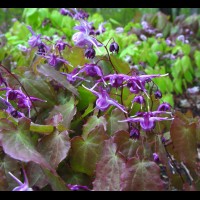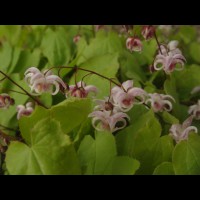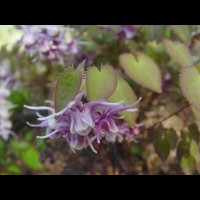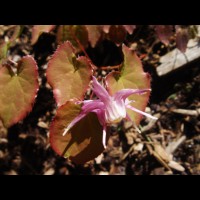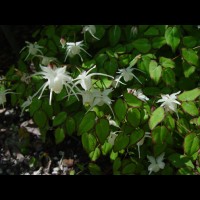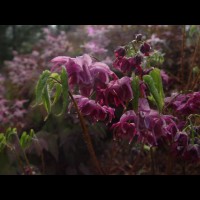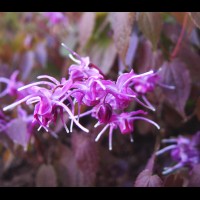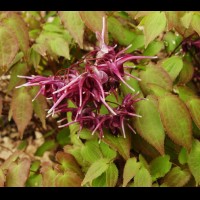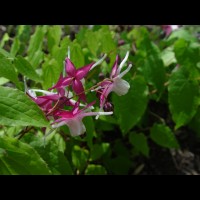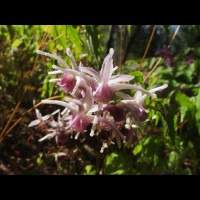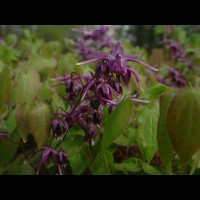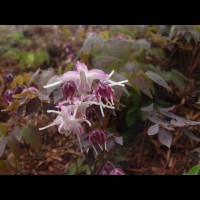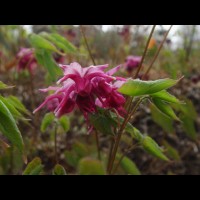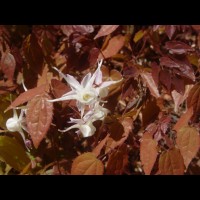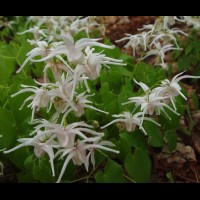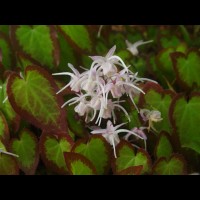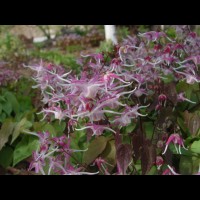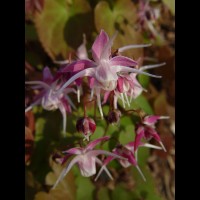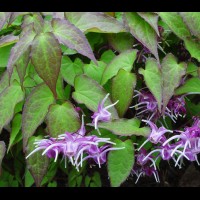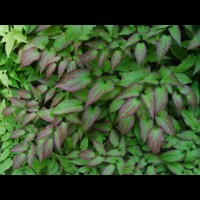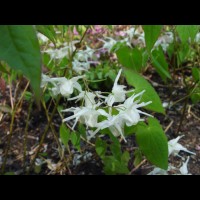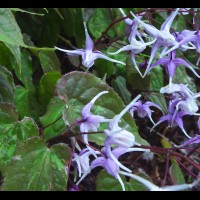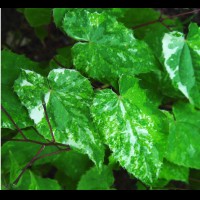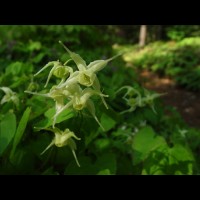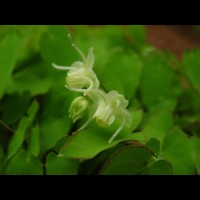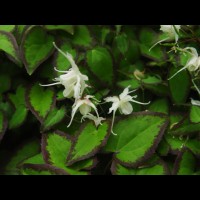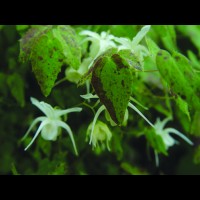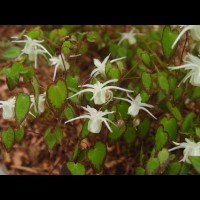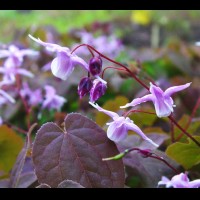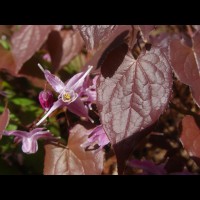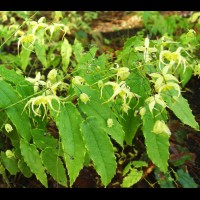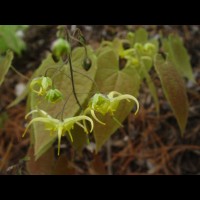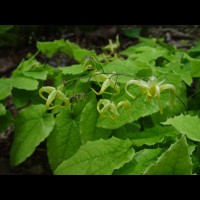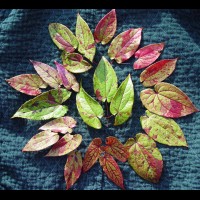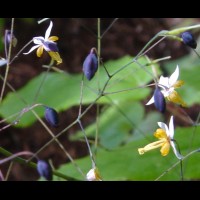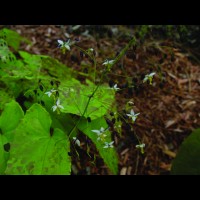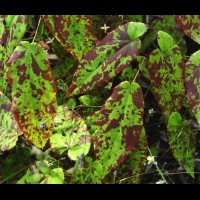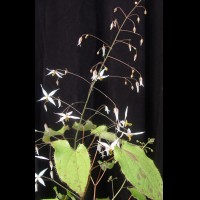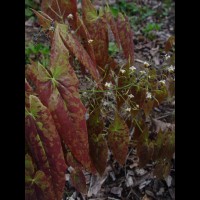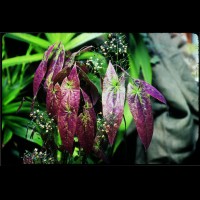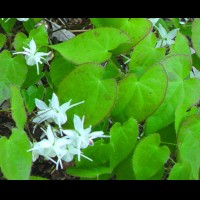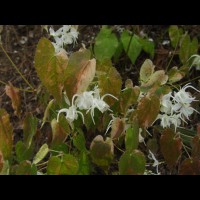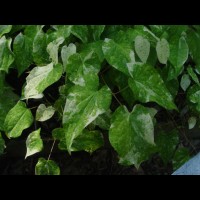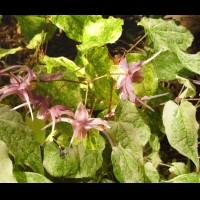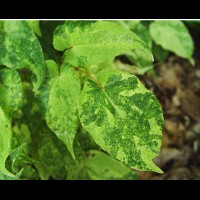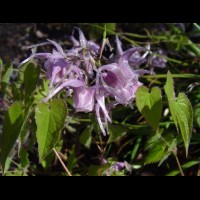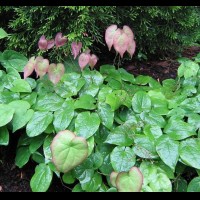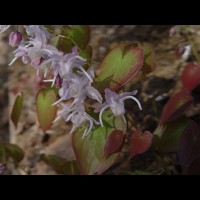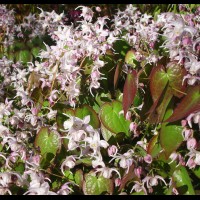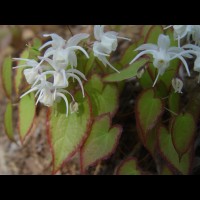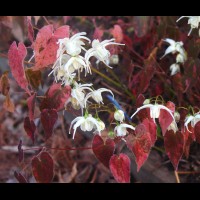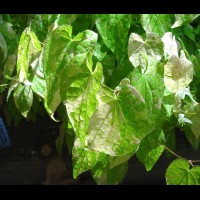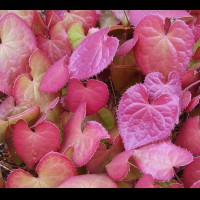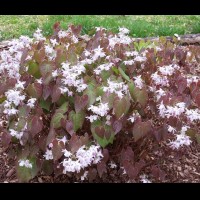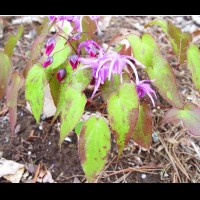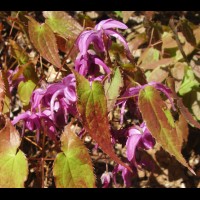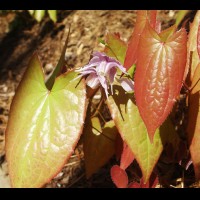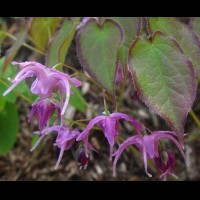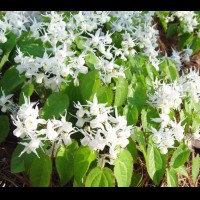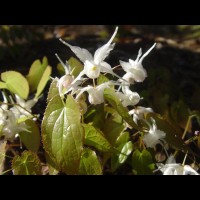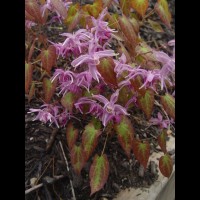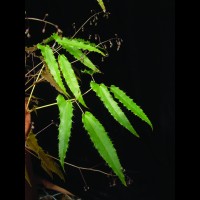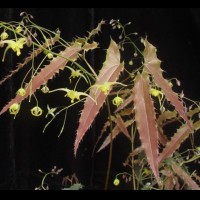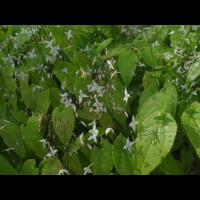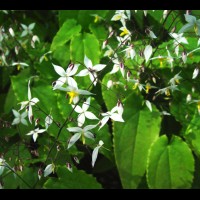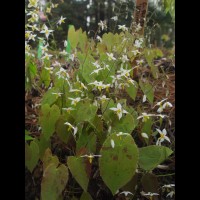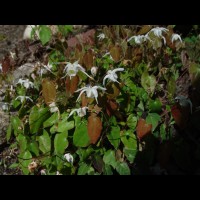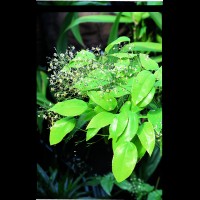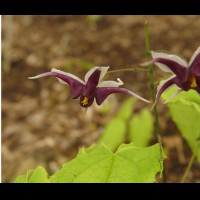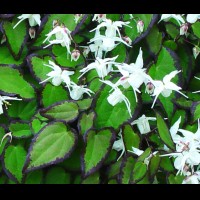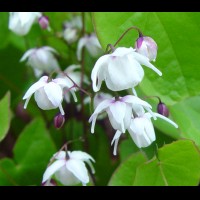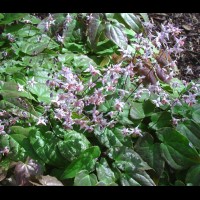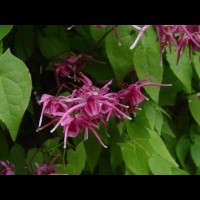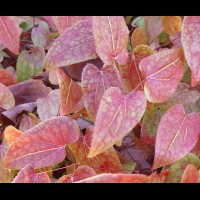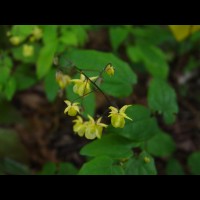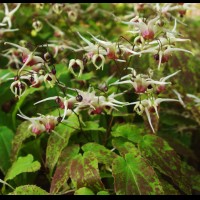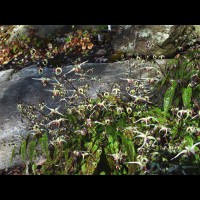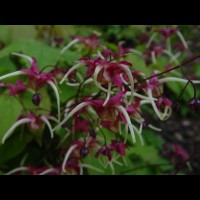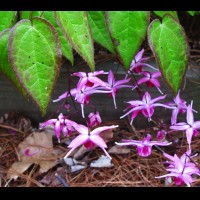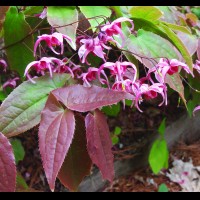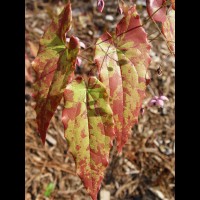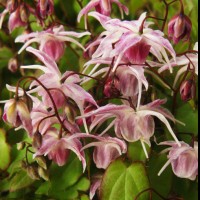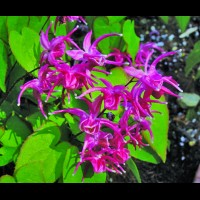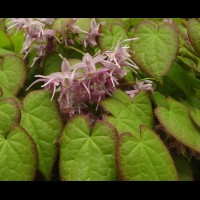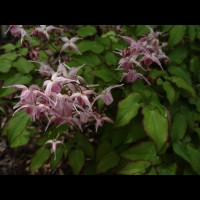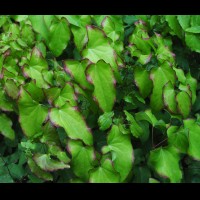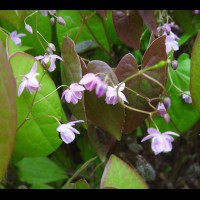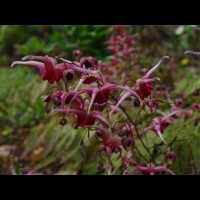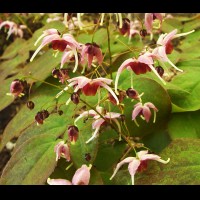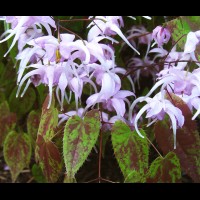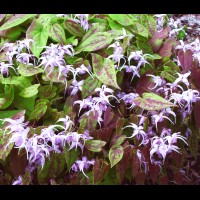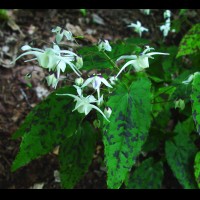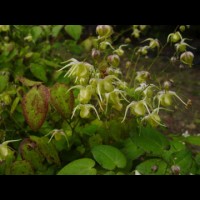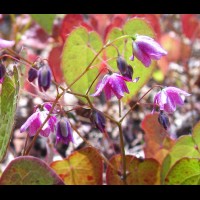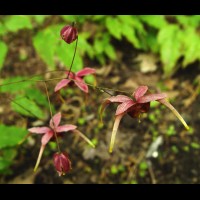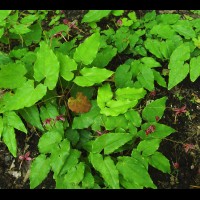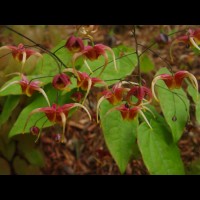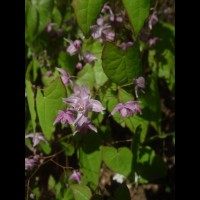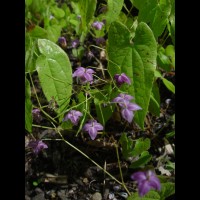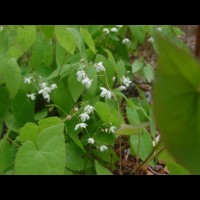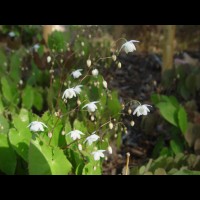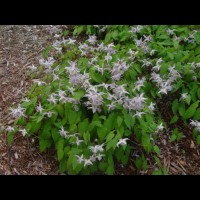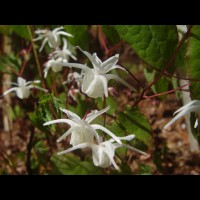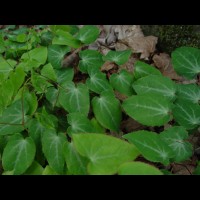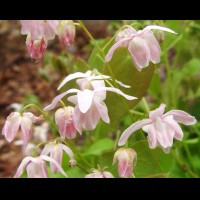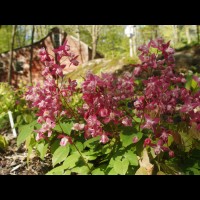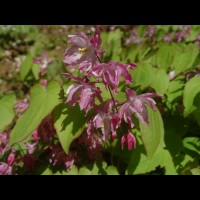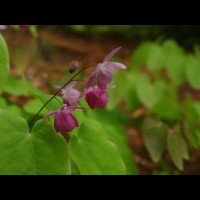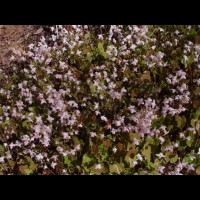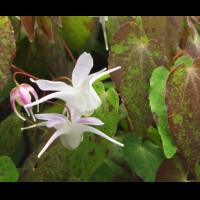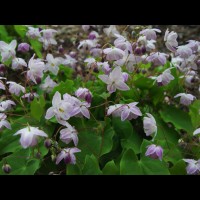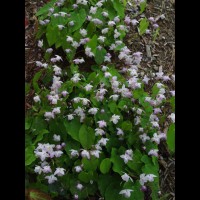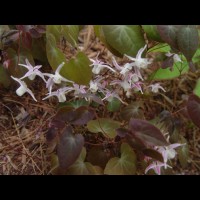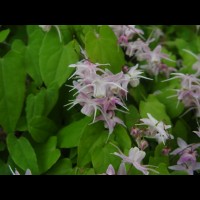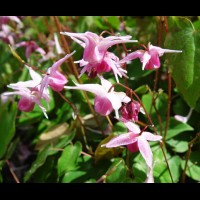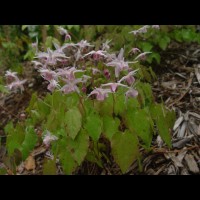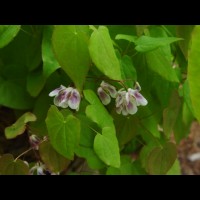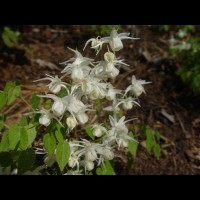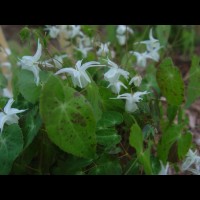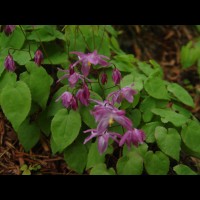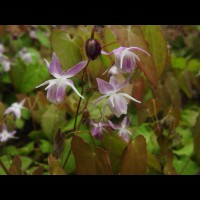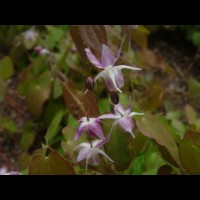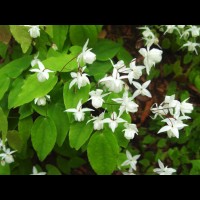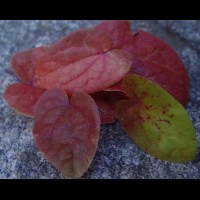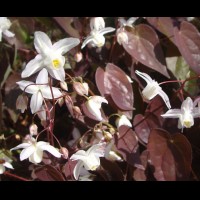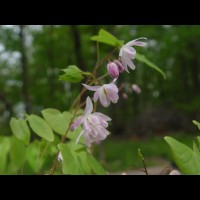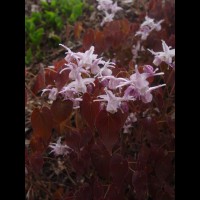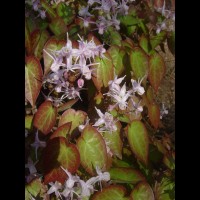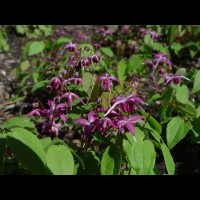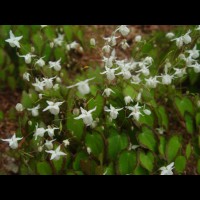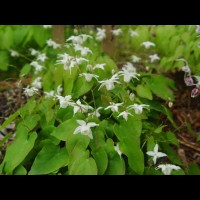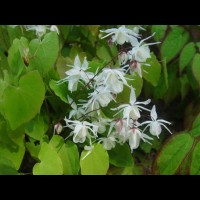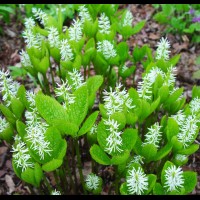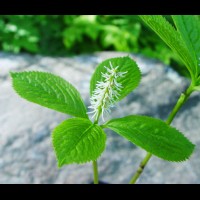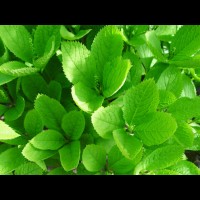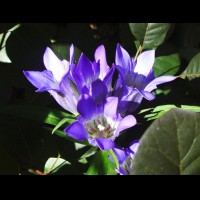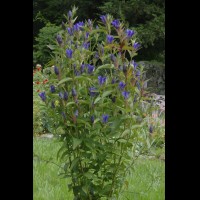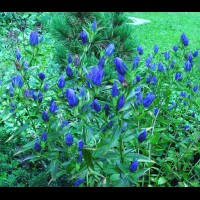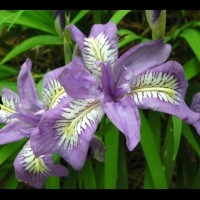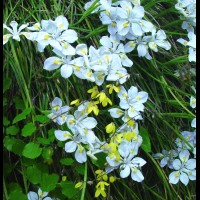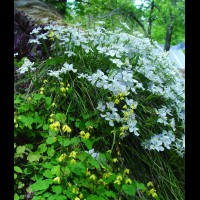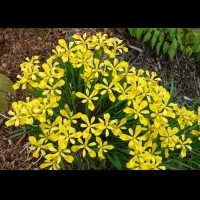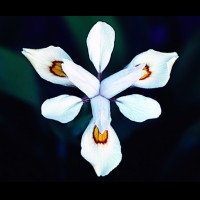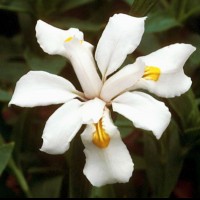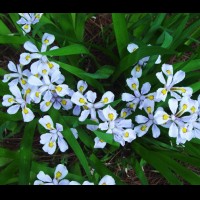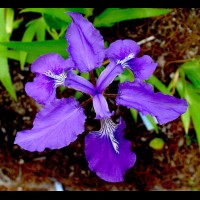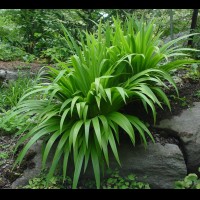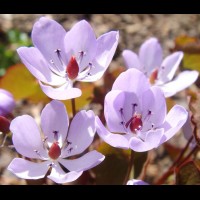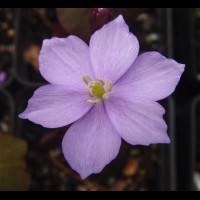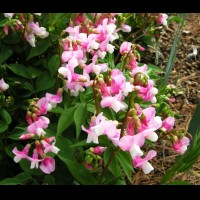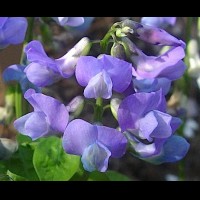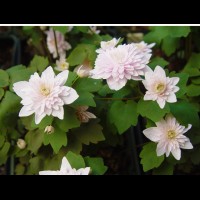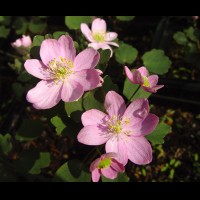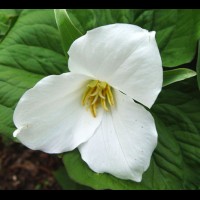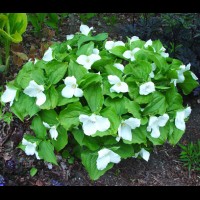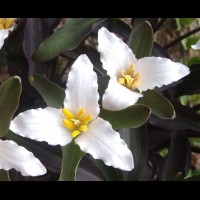Epimedium acuminatum
Epimedium acuminatum (Cc. 930001)
This species was originally collected by Mikinori Ogisu in the late 1970’s, and first introduced into the U.S in 1982. Several new introductions have arrived since, but this clone is the most dwarf at 8-10”. Relatively small evergreen leaflets, bright green in spring with shadows of purple flecks. The large flowers have white inner-sepals and grape-purple petals/spurs. Foliage 8-10" high at maturity.
Epimedium brachyrrhizum
Epimedium brachyrrhizum (Several clones/Cc. numbers)
Discovered in 1994 in Guizhou Province, China, it is one of the shortest species at only 6-8" tall, and among the largest flowered and earliest to bloom, with lavender-pink flowers nearly 2" across! New leaflets may be handsomely mottled with red-maroon in spring. Dark evergreen leaflets have a distinct corrugated surface, and many clones take on maroon overtones in fall. Not available this year.
Epimedium brachyrrhizum 'Karen'
Epimedium brachyrrhizum ‘Karen’ (Cc. 940526)
After years of trialing this plant against other superior forms of E. brachyrrhizum this stands out as the best for its prolific, large flowers in a soft shade of lavender-pink, combined with large leaves, heavily mottled with deep cranberry-rose in the spring. E. brachyrrhizum just happens to be one of my favorite Epimediums, so Darrell named this outstanding clone in my honor. 7” tall. Evergreen.
Epimedium brevicornu
Epimedium brevicornu (Several clones/Cc. numbers)
A beautiful hardy, deciduous species native to the northern regions in China where Epimediums are not normally found. These are divisions from plants collected during Darrell’s 2001 expedition to Henan Province where no Epimediums had been previously recorded. Produces an 8 to 10” high mass of small, rather round, heart-shaped leaflets. Numerous 10” long spikes carry “clouds” of small, star-shaped white flowers, each with short, reflexed spurs with a hint of yellow in the center. New leaflets may be speckled with reddish-purple and are thin and reminiscent of parchment paper to the touch. Hardy to Zone 4 and perhaps even 3! Early and long blooming, sometime for up to a month! $22
Epimedium davidii 'Emerald Sheen'
E. davidii ‘Emerald Sheen’ (Cc. 960085)
***2008 Cobblewood™ Introduction***
Extremely glossy leaflets are what makes this clone spectacular. It forms a mass of low growing, shiny foliage with smaller than normal, evergreen leaflets. The new spring foliage is tinted maroon. Flower stems are 12-24” tall with long spikes of many large, rich yellow flowers with tiny red inner-sepals. It is clump-forming, but produces occasional 3–5” rhizomes. Excellent for breeding, in that it passes the sheen of its foliage along to its offspring.
Epimedium diphyllum Cc. 940545
Epimedium diphyllum (Cc. 940545)
Only 5 to 10" tall in bloom, produces dainty, spur-less white, bell-shaped flowers over an extended period in spring for a very delicate effect. One of several clones imported from Japan. Semi-evergreen. Not available this year.
Epimedium diphyllum "Large Leaf Form"
E. diphyllum “Large Leaf Form” (Cc. 950062)
With the largest plant habit of E. diphyllum by far, its bolder leaflets are upwards of 4” long, 1-1/2” wide. White flowers slightly larger than other clones, on stems 10-12” tall. Semi-evergreen.
Epimedium diphyllum 'Nanum'
E. diphyllum ‘Nanum’ (Cc. 950054)
A sparkling gem at only 2-4" tall at first bloom, and covered in white bell-shaped flowers. Ultimately reaches 8" high. Ideal for shady rock gardens, path edges or troughs.
Epimedium diphyllum 'Variegatum'
E. diphyllum ‘Variegatum’ (Cc. 950164)
(Synonyms: 'Shiro tiri fu', 'Shiro chiri fu')
Friends Roy Herold and the late Gerry Anderson bought this plant back from Japan for Darrell in 1995. The leaflets are variously stippled—some leaves are green with flecks of white, others white flecked green. The white variegation is enhanced with 2-3 hours of direct daily sun in our nursery. Dainty white flowers hover above leaves reminiscent of small spattered painter’s palettes. Foliage gradually turns greener through the season, but the variegation is still evident in the fall as the foliage turns to rusty red. 12" tall.
Epimedium dolichostemon
Epimedium dolichostemon Og. 81010 (Cc. 980078)
Narrow, evergreen, medium-sized arrow-shaped leaflets, heavily mottled with burgundy in the spring. Each small uniquely shaped flower has beautiful, reflexed, white inner-sepals and red petals with short, strongly curved spurs. 18” tall. In 1998, Robin White generously shared a blooming plant.
Darrell was awestruck the first time he saw slides of this clone. Lois Himes, garden assistant to Harold Epstein, took them of a plant exhibited by Robin White when she accompanied Harold to a 1995 Royal Horticultural Society show in London. It is far superior to the Ogisu clone (Og. 81011-- which is unfortunately terribly virused) making the rounds in the U.S.
Epimedium fargesii
Epimedium fargesii (Several clones/Cc. numbers)
The typical forms of a very choice species and the main target of Darrell’s November 2000 collecting trip to China. He gathered small divisions from a variety of plants at seven locations. 12-18” tall in bloom, with narrow, medium-sized arrow-shaped, dark evergreen leaflets, that persist in the winter garden.
The medium-sized flowers typically have long, white/pale lavender inner-sepals that wrap around smaller, lavender spurs. Often both reflex backwards. Foliage exhibits dark maroon flecking in spring and sometimes fall. First flush 8-10", second growth flush to 15".
Epimedium grandiflorum
E. grandiflorum (Cc. 920009) (Synonym: E. macranthum)
The typical form of the species in the U.S., with rosy inner-sepals, and creamy-white spurs and cup. The small new spring leaflets have a brown-purple cast to them that nicely complements the flower color. 7" tall in bloom, with a second growth flush to 14".
Epimedium grandiflorum 'Album'
E. grandiflorum ‘Album’ (Cc. 950063)
A favorite of Darrell's since the first time he saw it in Harold Epstein’s garden, as it really stands out, very fresh and bright in the spring. Originally imported from Japan, it has large, pristine white flowers suspended above small, crisp apple green spring leaflets for a strikingly clean contrast. 6” tall in bloom, second flush reaches 12-14”. Not as strong a grower as many other E. grandiflorum varieties.
Epimedium grandiflorum 'Benedict's Violet'
E. grandiflorum ‘Benedict’s Violet’ (Cc. 950130)
This seedling originated in Dr. Herb Benedict’s garden in Hillsdale, MI. Large, reddish-grape flowers hover over young spring green leaflets with a rosy edge. 9” tall with no second growth flush. Very floriferous. A shorter Epimedium that quickly forms a clump.
Epimedium grandiflorum 'Bicolor Giant'
E. grandiflorum ‘Bicolor Giant’ (Cc. 970206)
Bold, cheerful and bright flowers and later the large leaves both make a nice show from a distance. The large flowers exhibit in-curved sugary pink spurs under wide, deep raspberry sepals. The flowers bloom from underneath the leaves, but are produced in such profusion, that they are showy nonetheless.
After bloom, the large new spring leaflets blush with red before turning to their summer green. Another giant red similar to ‘Red Queen’ and ‘Orion’, but with a bi-colored bloom. Acquired in from Gotemba Nursery, Japan in 1997 as a “pink grandiflorum”. 16” tall in flower. It has exhibited yellow, rusty orange and maroon fall colors here in Massachusetts. Forms a substantial clump that reads as a small shrub in the perennial border.
Epimedium grandiflorum 'Circe'
E. grandiflorum ‘Circe’ (Cc. 950244)
***2006 Cobblewood Introduction***
Beautiful large rose-red flowers accented with white spur tips have caught the eye of many a visitor to our open nursery weekends. This cultivar has much the same characteristics to recommend it as Epimedium grandiflorum ‘Yubae’ but with 2-3 times the number of bloom stems held above the foliage, and a shorter stature. Heavily flowered with a slightly darker cast to the young foliage. Medium-sized leaflets form a mound to 13”. An early bloomer hybridized by Darrel Probst.
Epimedium grandiflorum 'Cranberry Sparkle'
E. grandiflorum ‘Cranberry Sparkle’ (Cc. 950162)
***2002 Cobblewood™ Introduction***
Darrell’s friend Don Elick spent five days in April 1995 on a whirlwind dash through southern Japan searching for select forms of wild Epimediums that might prove useful in Darrell’s breeding program. This was his most incredible find with large, rich cranberry flowers held out horizontally on 6” stems. The small leaflets are flushed bronze in spring. Very, very late to emerge and one of the last grandiflorums to bloom. 10” tall.
Epimedium grandiflorum 'Dark Beauty'
E. grandiflorum ‘Dark Beauty’ (Cc. 950132)
Harold Epstein admired this plant for its velvety, deep chocolate-purple new spring foliage. It appeared as a seedling in his garden from an apparent cross between ‘Yubae’ and ‘Silver Queen’. Its large flowers have beautiful dark rose inner-sepals and white petals/spurs flushed with rose. Small leaflets. 8” in bloom with second flush to 12”. A strong grower and one of the first “Eps” to emerge and bloom each year in the nursery.
Epimedium grandiflorum 'First Kiss'
E. grandiflorum ‘First Kiss’ (Cc. 920019)
One of the smallest grandiflorums. Large flowers are produced just above the first set of leaves at only 4” tall. Dark lavender-rose flowers have white accents on the rim of the cup and the spur tips. Small spring leaflets are flushed purple. Second flush to 9”. Its short stature makes it great for troughs or the front of the shade border.
Epimedium grandiflorum 'French Braid'
E. grandiflorum ‘French Braid’ (Cc. 960042)
***2007 Cobblewood Introduction***
This eye-catching, vigorous, bold-foliaged seedling from Harold Epstein’s garden stands out from the pack with its bright, almost tropical spring leaf coloration. A psychedelic shade of orange flushes the edge of the leaflets that are dissected by luminous chartreuse veins flowing into an all green center. Large, elongated, overlapping leaflets tumble downward in a zig-zag pattern. Large creamy white flowers are borne underneath the expanding leaflets. 14” in bloom.
Epimedium grandiflorum 'Lavender Lady'
E. grandiflorum ‘Lavender Lady’ (Cc. 950094)
***2000 Cobblewood Introduction***
This beauty appeared as a seedling in Harold’s garden as a cross between E. sempervirens ‘Violet Queen’ and E. grandiflorum ‘Silver Queen’. Its red leaf color comes from the former and its numerous leaflets from the latter. It forms a mass of wide-spreading, low-growing leaves composed of medium-sized leaflets, their edges suffused with a deep red that fades into a soft green, netted center. This beautiful mass of foliage is topped by full panicles of large, lavender flowers with white spur tips. 8” tall in bloom. No second growth flush. Striking reddish-orange fall color. Early bloomer with a distinctly horizontal growth habit. Semi-evergreen.
Epimedium grandiflorum 'Lilac Seedling'
E. grandiflorum ‘Lilac Seedling’ (Cc. 960019)
Friend Teyl de Bordes of Scotland selected this outstanding seedling from a batch at Washfield Nursery. Medium-large, arrow-shaped leaflets emerge a spectacular deep reddish-purple in spring etched in bright green along the main veins. The color remains for about a month before turning green. 12-18” tall. Dense heads of large light lavender and white flowers are produced below the new leaves. Very showy.
E. grandiflorum 'Lilafee'
Epimedium grandiflorum 'Lilafee' (Cc. 910001)
A popular favorite for its large, delicate, violet-purple flowers with white spur tips held above small, purple-tinted spring leaflets. Reaches 8” tall in bloom with a second flush to 14” tall.
Epimedium grandiflorum 'Mizuhomaru'
E. grandiflorum ‘Mizuhomaru’ (Cc. 970236)
(Synonym: ‘Sakaru Moru’)
A curious Japanese cultivar with spurs that curve sharply inward towards the cup in cold temperatures. This unique flower form makes it a popular choice when seen in bloom at our on-site nursery sales. Medium-sized, pale lavender-purple flowers. Small leaflets. 8” tall in bloom; second growth flush to 12”. Leaves sometimes turn shrimp pink in the fall.
Epimedium grandiflorum 'Mt. Kitadake Purple'
E. grandiflorum ‘Mt. Kitadake Purple’ (Cc. 950031)
Large, intensely rose-violet flowers are held above richly colored foliage. White highlights along the outer edges of the flower resemble crisp white piping. The muted red tones of the early spring foliage later fade to a rosy band at each leaf edge, encircling a light green center with a slight rose blush. The small leaflets are fringed with long white spines, likened to white eyelashes by one of my more enthusiastic customers! 6-7” in bloom, second flush to 10”.
Epimedium grandiflorum 'Mt. Kitadake Red'
E. grandiflorum ‘Mt. Kitadake Red’ (Cc. 960020)
A darling little plant, beginning its bloom with leaves only 5” tall. The large, rose-red flowers are held above the foliage at 7” high. A second flush of leaflets follows on stems to 10”. Each small leaflet is tinted with bronze to dark reddish-purple in spring. This clone has exhibited pink and yellow fall color in the nursery.
Epimedium grandiflorum 'Nanum'
Epimedium grandiflorum ‘Nanum’ (Cc. 950149)
Perfect for a shady trough garden or border edge at only 3-5” in bloom. Second growth flush of foliage later reaches 10” in height. Medium-sized white flowers are in proportion to the size of the plant as are the tiny, rounded spring leaflets, each with a light purple band around their edge in spring. Particularly late to emerge in spring.
Epimedium grandiflorum 'Orion'
E. grandiflorum ‘Orion’ (Cc. 920020)
A giant “red" flowered Epimedium, probably originating from central Honshu in Japan. Grows 14 to 18” tall at bloom time, with large leaflets, and no second flush of growth. Large violet-red flowers are produced in profusion held below the large, bold leaflets. Flower color reads from a distance in the garden. Named by Dick Weaver.
Epimedium grandiflorum 'Pierre's Purple'
E. grandiflorum ‘Pierre’s Purple’ (Cc. 950124)
***1999 Cobblewood Introduction***
Named for Pierre Bennerup of Sunny Border Nurseries who originally shared it with Darrell. 7” tall in bloom, with a second growth flush to 15”. Beautiful, large, rich wine-purple flowers with white spur tips are borne against small leaflets flushed bronze in early spring. The intense spring color of the leaflets elicits many comments during our bloom season, but gradually fades as the flowers age. Leaflets turn a limey green in mid-autumn.
Epimedium grandiflorum 'Princess Susan'
E. grandiflorum ‘Princess Susan’ (Cc. 960044)
***1999 Cobblewood Introduction***
A beautiful, large-flowered selection from Harold Epstein’s garden, named after his daughter. Flowers are a crisp contrast of cherry-rose inner-sepals and pure white petals/spurs against small, bright green leaflets. Foliage grows more horizontally than that of other Epimediums. 8” in bloom with a second growth flush to 13”. A late bloomer.
Epimedium grandiflorum 'Pseudo Larchmont'
E. grandiflorum ‘Pseudo-Larchmont’ (Cc. 950115)
***1998 Cobblewood Introduction***
This unusually large, floriferous clone bears masses of creamy-lavender and purple blossoms with arching spurs that billow out from under the edges of the foliage. As a rule, it produces only 9 leaflets per leaf, instead of up to 15, giving bolder texture. The leaflets are dark green, narrow, and distinctively angular in shape. A strong grower, ‘Pseudo-Larchmont’ grows to 8” in bloom, with a second growth flush to 20+”.
Epimedium grandiflorum 'Purple Prince'
E. grandiflorum ‘Purple Prince’ (Cc. 950123)
The richest, deepest purple form of E. grandiflorum that we’ve ever seen. Visitors often remark at its exceptional beauty, even in bud. Spring leaves emerge a muted rose. 8” tall in bloom, with a second flush to 18”. Small leaflets, medium-sized flowers. An early bloomer.
Epimedium grandiflorum 'Queen Esta'
E. grandiflorum ‘Queen Esta’ (Cc. 920021)
A beautiful cultivar named by Harold Epstein after his wife, Esta. It was the first named seedling ever introduced from his garden. Notable for its large flowers with dark lavender inner-sepals and pale lavender spurs held against the chocolate-brown new spring foliage. It grows 6-8” tall in bloom, with a second flush of new dark leaves to 12”. Small leaflets. One of the earliest E. grandiflorums to bloom in spring.
Epimedium grandiflorum 'Red Queen'
E. grandiflorum ‘Red Queen’ (Cc. 950055)
Harold Epstein bought this imposing plant in Japan many years ago, and nicknamed it “Red Queen”. As far as we can determine, it was not a named cultivar. Large, vivid, rose-red flowers peek out from under huge leaflets that may grow to 6” long/4” wide. The bold fall foliage of this regal Epimedium sometimes turns shades of pink/orange. A second growth flush of red-tinted foliage reaches to 14”. A vigorous, bold-textured choice that makes a substantial clump over time.
Epimedium grandiflorum 'Shiratama'
Epimedium grandiflorum ‘Shiratama’ (Cc. 970068)
Ozzie Johnson of Marietta, GA brought back this striking cultivar from Japan. It produces masses of delicate 1” pristine white flowers with long, thin, elegant and prominently curved spidery spurs above a bun of medium-sized, bright apple-green leaflets at only 5” tall. Crisp and clean look to flowers and foliage. Second growth flush to 14”.
Epimedium grandiflorum 'Silver Queen'
E. grandiflorum ‘Silver Queen’ (Cc. 900003)
Very textural with leaves usually divided into 27 small leaflets that are mahogany-flushed in spring. The large white flowers have "silvery-lavender" highlights on the inner-sepals. 7" tall in bloom, second flush to 11". A parent of many cultivars. An early bloomer.
Epimedium grandiflorum 'Sirius'
E. grandiflorum ‘Sirius’ (Cc. 920024)
A 1990 Dick Weaver introduction, ‘Sirius’ originated as a seedling in Harold Epstein’s garden. The large and delicate palest of pink flowers float above small, distinctively light green leaflets. Often only 5” tall in bloom, with a second flush of growth to 10”. Blooms at the "tale-end" of the Epimedium season.
Epimedium grandiflorum 'Spring Wedding'
E. grandiflorum ‘Spring Wedding’ (Cc. 950237)
2003 Cobblewood Introduction
The fresh spring foliage of this selection emerges dark purple, then lightens and expands to display a bold, 1/4” wide, mahogany-red edge. Very floriferous, it produces numerous flower stems held well above the foliage. The medium-sized flowers have soft lavender sepals backing white petals with downward curving spurs. A plant handsome in both flower and foliage. 10” tall in bloom. Semi-evergreen leaflets hold well into autumn when they turn a limey shade of green. It tolerates alkaline soils better than most E. grandiflorums.
Epimedium grandiflorum 'Swallowtail'
E. grandiflorum ‘Swallowtail’ (Cc. 950238)
***2003 Cobblewood™ Introduction***
A flurry of slim, streamlined and graceful, medium-sized flowers are borne both above and among the numerous small leaflets edged with a hint of purple. The second growth flush has even better foliage color for an extended season of beauty. The flowers have sepals that are blue-lavender streaked in rose. Angular white spurs have a lavender streak and a slight downward tilt. 7” in bloom with a very horizontal growth habit. Second growth to 12". Unlike most grandiflorums, it tolerates alkaline soils.
Epimedium grandiflorum 'Tama No Genpei'
E. grandiflorum ‘Tama No Genpei’ (Cc. 950039)
A floriferous, showy Japanese selection with masses of large, crisp, bi-colored lavender/pink and white flowers held above the foliage. The lovely flowers paired with attractive purple-flecked new spring foliage gives the plant a very soft look in bloom. First blooms are held on 8” stems, with stems elongating to 16”. Small leaflets.
Epimedium grandiflorum 'Waterfall'
E. grandiflorum ‘Waterfall’ (Cc. 950113)
***2003 Cobblewood Introduction***
A large, lively, textural garden plant, full of movement. This appeared as a spontaneous seedling in the garden of Harold Epstein between E. grandiflorum f. flavescens ‘La Rocaille’ and E. grandiflorum ‘Yubae’. The medium-large, acutely tapered leaves stack in layers giving the appearance of flowing water. In spring, purple stippling is strongest at leaf edge, with an irregular mosaic of purple/red and green in the center, fading to green at the petiole. Large flowers gush forth on stems angled upward along the fringes of the foliage. Deep rose-purple sepals angle back from white spurs that flush amethyst as they near the narrow cup. 16” in bloom with colorful second growth to 20".
Epimedium grandiflorum 'White Queen'
E. grandiflorum ‘White Queen’ (Cc. 950168)
Common in the U.K., but quite rare in the U.S., Darrell received his original start of this cultivar from Dan Hinkley upon their first meeting in 1995. ‘White Queen’ has handsome, medium-sized, dark green arrow-shaped leaflets on stems to 14”. It produces no second growth flush. The edges of leaflets are flushed red in spring, while masses of large pure white flowers bloom just below the foliage.
Epimedium grandiflorum 'White Splash'
E. grandiflorum ‘White Splash’ (Cc. 970198)
Early spring leaflets are marked in a bright batik of olive, apple green, soft salmon-pink and white. As the foliage matures, the pink fades, leaving white irregular patches against a patchwork of many shades of green, lasting well into the season.
This plant came from Japan as “E. grandiflorum – Variegated”. We gave it a cultivar name to distinguish it from the others sold as such in Japan. Flowers are similar to those of the species, with medium-lavender inner sepals and white spurs. A smudge of lavender decorates the white cup. To 12” high.
Epimedium grandiflorum 'Yellow Princess'
E. grandiflorum ‘Yellow Princess’ (Cc. 940547)
***2000 Cobblewood Introduction***
Simply beautiful, the small leaflets of this form a low 5-1/2” mass with large, clean, light yellow flowers held aloft on stems to 10”. The spent flower stems are eventually engulfed by a second growth flush. From high elevations in Japan, it emerges late and is one of the last of E. grandi
Epimedium grandiflorum 'Yubae'
E. grandiflorum ‘Yubae’ (Cc. 920022)
(Synonyms: ‘Crimson’, 'Crimson Beauty’, 'Rose Queen’)
One of my favorites, this plant is often mislabeled as ‘Rose Queen’. It arrived in the west many decades ago, already given the name ‘Yubae’ in Japan, but with only Japanese characters to go by and no translation it was probably soon given an English cultivar name. Incidentally, this same plant suffered a third renaming in the U.K. when another plant, ‘Tama No Genpei’, was going around as ‘Rose Queen’ so it was re-named ‘Crimson Beauty’, perpetuating the confusion.
Yubae’s beautiful large rosy-red flowers have white spur tips. This bright flower color can read from a long distance in the garden. The young foliage, purple-bronze in spring, is only 8” tall at first bloom. A second flush of flowers and foliage reaches 18”. Early bloomer.
Epimedium grandiflorum f. flavescens 'LaRocaille'
Epimedium grandiflorum f. flavescens ‘La Rocaille’ (Cc. 950040)
Originally offered in the 1970’s as E. grandiflorum f. flavescens by George Schenk of The Wild Garden, Bothel, WA. Plants established in Harold’s garden 25 years before grew into a large mass 6’ across. Its vigorous habit, long arrow-shaped leaflets and large, pale yellow flowers moved Harold to name it after his garden. Foliage is flushed a beautiful red in spring. 14” tall.
Epimedium grandiflorum var. coelestre 'Alpine Beauty'
E. grandiflorum var. coelestre ‘Alpine Beauty’ (Cc. 950058)
***2000 Cobblewood Introduction***
Extremely rare in the wild and in cultivation, this is the only Epimedium that grows at montaine heights. Beauti
Epimedium grandiflorum var. higoense 'Bandit'
E. grandiflorum var. higoense ‘Bandit’ (Cc. 950057)
Although Darrell has obtained this clone from several sources, he has traced it back to a 1981 We Du Nursery purchase from Japan. It is very different from the clone he got from them eleven years later. After many years of trialing, he named it in 2000 as it is very distinct and has the most striking, dark purple band around the edge of each small leaflet as it emerges in spring. Medium-sized, creamy-white flowers cover the plant at 6” tall, with a second flush of banded leaves to 10” as the older leaves green up. A customer favorite.
Epimedium grandiflorum var. higoense 'Confetti'
E. grandiflorum var. higoense ‘Confetti’ (Cc. 960144)
***2007 Cobblewood™ Introduction***
A marvel of texture. Each leaf is composed of up to 50 small leaflets, and most are uniquely speckled, flecked and splotched with dark purple in spring. Our leafiest clone of Epimedium by far. 7” high in bloom, bearing hordes of elegantly crafted, medium-sized white flowers. All flower parts are thin and tapered, the whole giving the effect of delicate spiders floating over the foliage.
Epimedium grandiflorum var. higoense 'Saturn'
E. grandiflorum var. higoense ‘Saturn’ (Cc. 920023)
A 1991 We Du introduction named by Dick Weaver for the maroon band that circles each tiny spring leaflet. Only 4 to 5” tall in bloom, the second growth flush may reach 8”. Medium-sized, creamy-white flowers. Foliage provides a fine-textured effect in the garden. Later to bloom than most grandiflorums.
Epimedium grandiflorum var. violaceum
E. grandiflorum var. violaceum (Cc. 890001)
Exquisite deep chocolate, small, spring leaflets form a lovely background for the bright, medium- lavender flowers. One of the very earliest Epimediums to emerge and bloom in the nursery. Makes a clump 8-10” in bloom, with a second growth flush to 12”.
Epimedium grandiflorum var. violaceum 'Bronze Maiden'
E. grandiflorum var. violaceum ‘Bronze Maiden’ (Cc. 920016)
***1999 Cobblewood Introduction***
Spring leaflets emerge a glossy mahogany-red, resembling molten chocolate. This intense color complements the medium-sized lavender flowers. 8” in bloom, with a second growth flush to 12”. One of the earliest epimediums to bloom. Semi-evergreen.
Epimedium ilicifolium
Epimedium ilicifolium (Several clones/Cc. numbers)
A particularly cold-hardy, Chinese evergreen species from Shaanxi Province. Darrell found it in three areas in Nov. 2000 at the highest elevation above snowline. He trudged up steep ravines through snow and freezing temps just to see it in the wild. The long, narrow, evergreen leaflets are especially spiny (ilici-=holly, folium=leaf), on stems to 10”. Large flowers with light green inner sepals and bright yellow spurs, on stems to 18”.
Epimedium lishihchenii
Epimedium lishihchenii (Several clones/Cc. numbers)
Collected by NACPEC in 1994 in Hubei Province, China, along with E. stellulatum. Produces large, bold evergreen leaflets that are heavy in substance. One of the few evergreen epimediums where the foliage makes it through many of our harsh winters. The large flowers have green inner-sepals and bright yellow spurs. Hardy to at least Zone 4. Grows to 12” tall. May exhibit various pastel shades in its spring foliage color. Fall color on some clones displays reddish markings on the leaves, as in accompanying photo.
Epimedium myrianthum
E. myrianthum (Several clones/Cc numbers)
Although the flowers of E. myrianthum are tiny, with over 100 flowers per stem, they create a billowy mass. White inner-sepals with yellow petals, and iridescent blue-black outer sepals enclosing the flowers in tight bud. Large, glossy, arrow-shaped evergreen spring leaflets are often lightly mottled with maroon. Shadows of that spring foliage mottling often reappear in the cool temperatures of fall. 18-20".
Epimedium myrianthum 'Mottled Madness'
E. myrianthum ‘Mottled Madness’ (Cc. 940110)
***2000 Cobblewood Introduction***
Of all of the plants and seedlings we have grown of this species, this clone stands out for its dark spring coloration. Large leaflets are heavily mottled for a month during spring, like a burgundy form of army camouflage. While the color eventually turns to green, it usually reappears once the temperatures dip in fall, and lasts through the winter in mild climates where the leaves remain evergreen. Bright airy panicles hold tiny white flowers that emerge from iridescently blue-black buds. 8-12”. Native to China.
Epimedium pubescens "Shaanxi Forms"
Epimedium pubescens “Shaanxi Forms”
(Several clones/Cc. numbers)
Epimedium pubescens is generally hardy from Zone 6 south, but these clones from Shaanxi Province have proven hardier, growing well in Zone 5. Forms a leafy clump 12” tall/wide with the flower panicles reaching to 16”. Medium-sized, evergreen spring leaflets are flecked with crimson, and mature to a glossy dark green with spiny margins. Starry flowers are borne in large airy panicles with 1/2” long, narrow, white reflexed inner-sepals and tiny orange-yellow spurred petals. Slightly spreading by 1-2" rhizomes.
Epimedium pubigerum Cc. 950215
Epimedium pubigerum (Cc. 950215)
This clone bears creamy-white flowers-- almost like tiny molars, creating a baby's breath effect-- held high above especially rounded, glossy dark green leaflets. Foliage 8-10" tall with flowers stems held at 16-20" tall. Drought tolerant. Semi-evergreen.
Epimedium sagittatum 'Warlord'
E. sagittatum ‘Warlord’ (Cc.021191)
2007 Cobblewood Introduction
A very handsome species, long desired for its exceptionally large, arrow-shaped, evergreen leaflets up to 9” long (in fertile soil and full shade). The spring foliage color of this clone is a spectacular mosaic of various shades of maroon covering the entire leaflet. Side leaflets have exaggerated outer lobes. Tiny flowers with white inner-sepals and golden spurs, are produced in congested panicles of 50 or more against the dark, glossy foliage. Grows to 18” tall here with much more narrow leaflets than the typical species. A slow grower, it forms an impressive clump over time.
Epimedium sempervirens
Epimedium sempervirens Cc. 950031
Medium-sized, crisp, white flowers bloom above long tapered leaflets. One of the earliest epimediums to bloom in spring. Foliage makes an 8” mound. Spring leaflets are touched with a band of red around their edge. A bright little harbinger of spring. Semi-evergreen.
Epimedium sempervirens "Variegated #1"
Epimedium sempervirens “Variegated #1” (Cc. 970190)
From Japan came rumors of a most spectacularly variegated Epimedium heavily dappled with white and pink and costing a small fortune. During Darrell's 1997 trip to Japan with Dan Hinkley he searched specifically for this fabled plant. Once he saw it he just had to have it—the most expensive Epimedium he's ever purchased! It was indeed the nicest variegated Epimedium he'd ever seen...and just as they said, the spring foliage is a swirling collage of creamy white, salmon-pink and apple green. What they didn’t mention was that the white portion of the variegation lasts well into the season.. into August here, before turning mostly green.
White flowers are produced above the semi-evergreen leaves. One of the shorter Epimediums at only 8” tall.
Epimedium sempervirens "Variegated #2"
An exceptional variegated form of Epimedium sempervirens. Strong grower despite the generous amount of foliage that is speckled and splotched with white. Medium lavender-rose flowers. Foliage 6 to 8" high at maturity. Keeps its variegation well into late summer. Limited quantity. Darrell obtained this clone from Japan. It will be a special conversation piece in your garden.
Epimedium sempervirens "Violet"
E. sempervirens “Violet” (Cc. 950069)
One of my absolute favorites. Grown for many years by Harold Epstein, Epimedium enthusiast, this may be a named Japanese cultivar. Medium-sized lavender flowers have spurs that curve inward back towards the cup. Flowers are held above medium-sized leaflets on stems to 9” high. Unusually long, narrow leaflets sport irregular dark flecking in the spring. Semi-evergreen.
Epimedium sempervirens 'Aurora'
E. sempervirens ‘Aurora’ (Cc. 920018)
Dwarf form with large, dark silky, silvery lavender blooms with glossy, small/medium-sized leaflets. 6" tall in bloom with a second flush to 9". The new growth displays occasional dark flecking in spring. Second flush may have a pink blush as the photo shows. Often has good orange-red fall color when grown in bright shade or some sun. Named by Dick Weaver and sold by We Du as a cultivar of E. grandiflorum. Semi-evergreen.
Epimedium sempervirens 'Candy Hearts'
Epimedium sempervirens ‘Candy Hearts’ (Cc. 920038)
***2001 Cobblewood Introduction***
Exquisite spring foliage emerges an opalescent rosy-pink tone that slowly recedes over a month’s time to a rose border, before turning solid green. The showy large silvery lavender-pink flowers have wide inner-sepals and look like iridescent pearls against the colorful spring foliage. 9” tall. Semi-evergreen with medium-sized leaflets.
Epimedium sempervirens 'Cherry Hearts'
Epimedium sempervirens ‘Cherry Hearts’ (Cc. 950016)
***2001 Cobblewood Introduction***
As Darrell began to sort out Epimediums in cultivation years ago, Don Elick kindly sent him this plant as “true” E. sempervirens. True it might be and while its large flowers are the usual white, with the typical evergreen leaves, the new spring foliage is anything but. Emerging a vibrant cherry red, it later turns green leaving a cherry edge before fading to summer green.
Epimedium sempervirens 'Creamsickle'
Epimedium sempervirens 'Creamsickle' (Cc. 050060)
I have been growing several variegated forms of E. sempervirens, and have finally decided that this one is different enough to offer. The new spring growth surrounds its clean, white flowers a riot of deep pink and olive green swirls of color for several days during bloom. Later the leaves green up, holding onto traces of white variegation. Leaves are more limey-green in variegation than the other E. semp. 'Variegated #1' that Darrell bought in Japan, and have offered for years.
Epimedium sempervirens 'Koji'
E. sempervirens ‘Koji’ (Cc. 930003)
An attractive Japanese cultivar with sprays of large, medium lavender flowers with white highlights that hover above a mass of medium-sized leaflets 10” tall. New spring leaflets flushed with bronze. A very early bloomer.
Epimedium sempervirens 'Mars'
Epimedium sempervirens ‘Mars’ (Cc. 920035)
A rare, rose-red form of this species, named by Dick Weaver from a plant he purchased from Japan. 6” tall in bloom with a second flush to 10” tall. Medium-sized leaflets. When grown well, ‘Mars’ produces up to 30 or more flowers per stem, forming a dense head. Very showy. Medium/large, dark rose-red flowers. Rusty red/salmon fall color.
Epimedium sempervirens 'Passion Hearts'
Epimedium sempervirens ‘Passion Hearts’ (Cc. 180040)
***2019 Cobblewood Introduction***
A great, new introduction from Massachusetts hybridizer Mark McDonough. Spring foliage emerges a deep chocolate brown and warms up as spring progresses, through a kaleidoscope of vibrant red tones. Eventually the color fades to the edges before greening up in a tidy mound of elongated, heart-shaped leaflets. Generous clusters of medium-sized flowers with light lavender sepals and a lighter cup dot the low mound of colorful spring foliage. Semi-evergreen.
Epimedium sempervirens 'Rose Dwarf'
E. sempervirens ‘Rose Dwarf’ (Cc. 950027)
Originally offered by George Schenk in the 1970’s and still quite rare in the trade. We thank Jerry Flintoff for our original stock. Plants 5” tall in bloom with unusually long, narrow, medium-sized leaflets, gradually tapering to a thin point and flecked with bronze in the spring. Flowers similar to those of Violet Queen’, dark violet-lavender with long inner-sepals. An early bloomer. Semi-evergreen.
Epimedium sempervirens 'Secret Arrow'
Epimedium sempervirens ‘Secret Arrow’ (Cc. 950140)
***2000 Cobblewood Introduction***
Unique, arrow-shaped leaflets distinguish this plant. Large lavender flowers face out¬ward with wide inner-sepals. Cool fall temperatures turn the leaves a beautiful salmon-egg red, with limey green streaks along the main veins
Epimedium sempervirens 'Shadow Dancer'
E. sempervirens ‘Shadow Dancer’ (Cc. 000943)
***2010 Cobblewood Introduction***
This Japanese sempervirens selection has strikingly beautiful banded foliage with a royal purple edge in spring, surrounding a interior flushed with purple. The large, violet-lavender blossoms have uniform coloring throughout. Grows to 12” in height. Semi-evergreen.
Epimedium sempervirens 'Snowshoe Lake'
Epimedium sempervirens ‘Snowshoe Lake’ (Cc. 920033)
***2014 Cobblewood Introduction***
A white flowered very floriferous form of this extremely early bloomer. Sited in bright shade or a couple of hours of sun a day, it will produce clouds of clean white medium-sized flowers, 6” above the ground at the first thaw. Leaflets sport a delicate red line along their margins in early spring.
A cheerful and fitting tribute to my late brother George who lived on Snowshoe Lake in Alaska. 8-10” at maturity. An early bloomer.
Epimedium sempervirens 'Vega'
E. sempervirens ‘Vega’ (Cc. 950211)
Named by Dick Weaver in 1995, but Darrell doesn’t think that he ever introduced it. He said, “the foliage seems almost varnished while young. It virtually glistens and it is still very glossy” (in mid-June). Dick’s original plant was from Leola Fraim of Waltham, MA in 1984. She received it from Florence Shaw in 1968. Leaflets remain glossy all season here, on stems to 6”. Pristine white flowers.
Epimedium sempervirens 'Violet Queen'
Epimedium sempervirens ‘Violet Queen’ (Cc. 950138)
A spectacular Epimedium. This clone is an exact match for the plant originally named Epimedium violaceum in 1834 which was later changed to a variety of E. grandiflorum... all through the study of dried herbarium specimens. However, this plant is semi-evergreen and nearly identical to other clones Darrell received from west central Honshu including the plant depicted in Don Elick’s book, Japonica Magnifica. Perhaps it is a species of its own. This is the parent that gifted E. x rubrum, E. x versicolor ‘Versicolor’ and ‘Cupreum’ with colorful spring foliage.
Prized for its vibrant, cherry-red new growth and large, rich violet-lavender flowers with very long inner-sepals. Small/medium leaflets have a long, tapered point. Slow to propagate. 12”
Epimedium sp. nov. 'Spine Tingler'
Epimedium sp. nov. 'Spine Tingler' (Cc. 001764)
***2008 Cobblewood Introduction***
A form of an as yet, unnamed Chinese species collected by Darrell Probst in Sichuan Province. The long, narrow (1”) spiny leaflets emerge with a light chocolate wash in early spring. Later long, overarching stems of large lemon-yellow spidery flowers float over a mass of exceptional evergreen foliage. To 10".
5Epimedium sp. nov. 'Tarantula'
Epimedium sp. nov. ‘Tarantula’ Cc. 012418
This clone has the narrowest leaves of any Epimedium in our entire collection. Delicate hair-like spines, run the edge of each leaf in a zig-zag pattern. Bears long, sprays of soft yellow flowers. Leaflets range in size from .25 to 5/8” across, and 3-4” in length, sporting an occasional simple leaf.
Epimedium stellulatum "Narrow Leaf Forms"
Epimedium stellulatum “Narrow Leaf Forms” (Sev. clones/Cc. #)
NACPEC (North American China Plant Exploration Consortium), is a group of ten botanic gardens and arboreta from across the U.S. and Canada, organized by the National Arboretum to explore areas of China on an annual or semi-annual basis. NACPEC has made several exciting discoveries, including this group of Epimedium stellulatum.
Discovered in several areas in the Qin Ling Shan of Shaanxi Province in 1996, the evergreen leaflets are medium in size, narrower than the original form and have especially spiny margins. 12-18”. The flowers are small white “stars” with tiny yellow petals on long, erect stems held well above the leaves. The floral display is like a miniature constellation suspended above spiny evergreen foliage. Early flowering and long-blooming, 12-18” tall. Hardy to Zone 4, possibly 3.
Epimedium stellulatum 'Wudang Star'
Epimedium stellulatum ‘Wudang Star’ L1193 (Cc. 960139)
Collected in the Wudang-Shan by Roy Lancaster, this clone was the original collection used to describe the species. Plants produce numerous sprays of small, starry-white flowers with minute yellow spurs over spiny, evergreen foliage. The faded maroon-flecked spring leaflets of this clone are much wider and rounded than those of the straight species. 12-18”.
Epimedium trifoliatobinatum
Epimedium trifoliatobinatum (Cc. 950046)
Found in only a few areas on Shikoku, Japan, it is treated as a valid species by Prof. W. T. Stearn. However, Darrell Probst thinks that it looks very much like a stabilized, true-breeding form of E. x youngianum, as the area to which it is endemic is within a region where E. grandiflorum and E. diphyllum naturally overlap. This clone is only 5” tall in bloom with a second growth flush to 9” tall. Medium-sized white flowers have spurs like E. grandiflorum but are smaller and in proportion to the overall diminutive habit of this clone. Small, rounded 1" wide, bronzed spring leaflets expand to green with maroon flecks.
Epimedium truncatum
Epimedium truncatum (Several clones/Cc. numbers)
The large, evergreen leaflets of E. truncatum differ in that the usual two basal lobes are missing, as if snipped off by scissors! They have a smooth, semi-gloss finish and are held on 15" stems. Open panicles to 21” hold numerous tiny white-sepaled, yellow petaled flowers, covered with striking blue-black outer sepals in bud.
Epimedium zhushanense
E. zhushanense (Several clones/Cc. numbers)
A new Chinese species, very rare in the trade, discovered near Zhushan and described in 1985. It is similar to E. acuminatum in leaf, flower and its clump-forming habit. The flowers have white or light lavender sepals and deep purple spurs and appear in spring on arching stems. A distinguishing characteristic of its large, evergreen, rough-surfaced spiny leaflets is their wooly undersurface. 8” high.
Epimedium 'After Midnight'
Epimedium ‘After Midnight’ (Cc. 031430)
This cultivar was introduced by Diana Reeck of Collector’s Nursery. The spring leaflets initially open a gorgeous dark chocolate brown color which tranforms into a maroon band around the edge as the leaves expand. Multitudes of medium-sized white flowers shine bright, well above the first flush of small, elongated leaflets. 6” in bloom to 12”.
Epimedium 'Anju'
Epimedium ‘Anju’ (Cc. 050047)
A very cute Japanese cultivar, with small, white flowers that have a tapered cup and short spurs. The medium-lavender outer sepals surround inner sepals with a kiss of lavender-pink at their base. Lime-green spring leaves have a thin, dark red margin at their edges.
Epimedium "Asiatic Hybrid"
Epimedium “Asiatic Hybrid” (Cc. 950166)
Washfield Nursery in England sold mixed seedlings of Asian parentage under the umbrella name “Asiatic Hybrid”, where Dan Hinkley originally purchased this clone. Tall sprays of delicate, small, pale pink flowers with deeper cups bloom above medium-sized, spring leaflets of a metallic pinkish-maroon hue. Blooms reach 12-15”. Semi-evergreen, arrow-shaped leaflets to 10".
Epimedium 'Beni Chidori'
E. 'Beni Chidori' (Cc 050001)
An attractive Japanese variety, given the name "a thousand red-birds chirping' and that is what it truly looks like in bloom- clusters of showy reddish-purple flowers with sepals a lighter shade of the same color. The medium-sized leaflets form a mound of bright green foliage to 10 in bloom, 18-20" high in second growth. Spurs are tipped in white. A very floriferous clone.
Epimedium 'Beni Goromo'
Epimedium ‘Beni Goromo’ (Cc. 050046)
A colorful, attractive Japanese cultivar with small, medium-lavender flowers held out in clusters against bronze-maroon spring foliage. The rich flower color lightens toward the tips of the curved spurs. Antique red fall foliage color. Reaches 12”-14”.
Epimedium 'Buttered Popcorn'
Epimedium ‘Buttered Popcorn’ (Cc. 960040)
***2001 Cobblewood Introduction***
This spontaneous hybrid between E. x setosum and E. davidi appeared in Harold Epstein’s garden in 1996. The plentiful, sunshine-yellow flowers bloom in long, thin sprays, just above the foliage to 15”. The charming small, yellow "box-shaped" flowers have a flared cup with short, sassy spurs and a red rim around the inner-sepals.
Small to medium-sized evergreen leaflets form a mass 10” tall. The leaflets are similar to those of E. davidii, but are longer and narrower, becoming dark green or even black-purple in winter. Grows more vigorously in northern gardens than E. davidii, producing a larger clump in less time.
Epimedium 'Domino'
Epimedium ‘Domino’ (Cc. 990614)
***2004 Cobblewood Introduction***
Absolutely stunning in the garden-- a true specimen epimedium. Long, showy panicles of creamy white flowers with an abbreviated maroon cup are highlighted against handsome mottled foliage in spring. Elegant elongated spring leaflets are sponge-painted in various shades of maroon. Deep reddish-purple outer sepals and dark purple pedicels. Forms a 12-14" mound of spiky evergreen foliage with soft spines, covered in a halo of long flower stems to 16”. May re-bloom and produce a second flush of mottled new growth to 18" under favorable conditions of humus-rich soil and adequate moisture.
Epimedium 'Flame Thrower'
Epimedium ‘Flame Thrower’ (Cc 990619)
***2009 Cobblewood Introduction***
Cheerful cherry red and creamy yellow flowers dance above the foliage of this hybrid from Darrell Probst. The inner sepals have decorative undulations to their shape, resembling flames licking upwards from the top of the flower. This cross between deciduous and evergreen parent plants gives this hybrid both vigorous growth and deep green, spiny leaflets of good substance. Drought-tolerant.
Epimedium 'Flamingo Dancer'
E. ‘Flamingo Dancer’ (Cc. 031432)
A Japanese selection named by Diana Reeck of Collector’s Nursery. Produces clusters of two-toned bright pink flowers. A narrow, deep cherry pink cup moves into lighter pink spurs subtended by darker sepals. Bright white spur tips make for a lively color combination. Each full panicle of bright flowers arches gracefully out over the beautifully speckled spring foliage. 10” high.
Epimedium 'Hot Lips'
Epimedium ‘Hot Lips’ (Cc. 031434)
An E. acuminatum hybrid from Diana Reeck of the former Collector's Nursery, with multi-toned flowers of hot pink with the long spurred petals that are decidedly hotter than the broad sepals. Flower stems are tinged burgundy red. Long narrow foliage emerges a reddish pink. Given a bit of bright shade or moderate sun in the north, the plant can reach 20” high. Its bright blooms and bold semi-evergreen foliage draws your eye from quite a distance.
Epimedium 'Kaguyahime'
Epimedium ‘Kaguyahime’ (Cc. 950225)
From Japan (via Mikinori Ogisu & Robin White) comes this delicately beautiful hybrid of E. acuminatum and E. dolichostemon. 15-18” stems carry sprays of small flowers with dark reddish-purple spurs and light rose-pink inner sepals. Long, slender arrow-shaped, medium-sized leaflets are jagged edged and beautifully mottled with various shades of red in spring. Vigorous for an semi-evergreen Epimedium, it is one of my favorites, and is named after a popular Japanese folk princess.
Epimedium 'Koharu'
Epimedium ‘Koharu’ (Cc. 050031)
Another floriferous Japanese selection. Medium sized flowers cover this plant. Flowers have a lavender pink cup backed by a lighter pink and white sepals with pink edges and spurs that lighten toward the tips. Flowers are held on dark red pedicels. The small spring leaflets edged in a thin red line.
Epimedium 'Kuki'
Epimedium ‘Kuki’ (Cc. 050002)
Heavy clusters of flowers dripping with deeply saturated color distinguish this beautiful Japanese selection. Numerous full clusters of reddish-purple flowers bloom against a background of fresh spring-green foliage. Each curved spur is tipped in white. A thin red line scribes the edge of each medium-sized new spring leaflet.
Epimedium 'Lilac Cascade'
Epimedium ‘Lilac Cascade’ (Cc. 950236)
***2001 Cobblewood Introduction***
In spring the new foliage emerges in beautiful shades of rose and pink. By bloom time, the leaflets turn almost solid green with a purplish-red border, forming a perfect mound of cascading foliage. Just above the leaves are clusters of rich violet-lavender flowers. Later, a second flush of vibrant hot raspberry-pink foliage emerges and remains colorful for several weeks. 6 to 8” tall in bloom with the second flush to 12-14”. From Darrell Probst's cross between E. sempervirens ‘Candy Hearts’ and E. grandiflorum ‘Yubae’. The foliage is like the former— semi-evergreen, medium-sized round hearts. Drought-tolerant.
Epimedium 'Making Waves'
Epimedium ‘Making Waves’ (Cc. 031433)
A 2003 Collector’s Nursery introduction, named for its exceptional wavy-edged leaflets with a soft, irregular maroon band in spring. Out-facing, long spurred mauve-pink flowers are accented with soft pink and held well above the foliage, on dark, nodding stems. Late blooming.
E. 'Mine No Fubuki'
E. ‘Mine-no-fubuki’ (Cc. 050035)
A delicate Japanese cultivar with chocolate-tinted new foliage, which balloons up to convex, light-green leaflets edged in bronze. Dainty, bell-shaped, spur-less flowers hang from drooping pedicels. They emerge a deep mauve and fade to a light lavender-pink. Delicate in flower with handsome, bold, semi-evergreen foliage to 14”.
Epimedium 'Pink Champagne'
Epimedium ‘Pink Champagne’ (Cc. 990618)
***2007 Cobblewood Introduction***
Perhaps the most all around beautiful Epimedium of those that Darrell has developed so far! Upright, heavy flowered panicles of pink and raspberry flowers float well above handsome, mottled foliage in spring. Medium pink sepals cap the top of each widely-arched spur. From the yellow spur tips that reveal their treasure of nectar, the color changes from white to a rich, berry pink, as if the cup was dipped in raspberry sorbet. Elongated, evergreen medium-sized arrow-shaped leaflets contrast purple mottling against a green background. A vigorous grower, it puts on an incredible show with occasional re-bloom if it is happy in its environment. 12" tall with flower stems reaching 16".
Epimedium 'Pretty In Pink'
Epimedium ‘Pretty in Pink’ (Cc. 130001)
This 2012 Plant Delights Nursery introduction by Tony Avent is a vigorous E. grandiflorum hybrid with exceptional foliage. Small clusters of large, showy flowers with pink spurs and a raspberry cup are held just above the leaves during the mid-late Epimedium bloom season.
The new spring growth is patterned with subdued maroon flecks, eventually hardening off as handsome, glossy, medium-sized green leaflets, followed by a flush of blush pink second growth foliage. Tony describes the leaflets as "tardily deciduous"-- what I call "semi-evergreen". One of the best for thick, lustrous summer foliage. To 12".
Epimedium 'Short Story'
Epimedium ‘Short Story’ (Cc. 170040)
***2019 Cobblewood Introduction***
A showy, robust, new hybrid from Massachusetts breeder Mark McDonough. This unique selection combines the best of evergreen E. brachyrrhizum and deciduous E. grandiflorum. Spring emergence starts with an upright filigree of bronze stems and small leaflets, giving high visibility to luscious clusters of large silvery pink flowers with conspicuously down-turned spurs. As the leaves expand they are mottled in soft red. The flowers are held high and more prominently than in brachyrrhizum, for a fine display. The second flush of semi-evergreen foliage is just as dramatic as the plant is in bloom, boldly marked with bright red over chartreuse green.
Epimedium 'Splish Splash'
Epimedium 'Splish Splash' (Cc. 150001)
This beauty is a 2013 Plant Delights Nursery introduction that is certainly worth of a place in the garden. The arrow-shaped spring leaflets are heavily mottled in rich mahogany during the cool spring weather. The dark green mottled foliage serves as a great background to show off the multitudes of clean white flowers. Up to 12" in bloom. Semi-evergreen.
Epimedium 'Sunshowers'
Epimedium ‘Sunshowers’ (Cc. 050101)
***2008 Cobblewood Introduction***
This diminutive in bloom, but fast growing cultivar was created by friend Kelly Dodson of Far Reaches Farm. Cheerful, medium-sized light yellow flowers with straight, outfacing spurs are backed by short pink sepals. Numerous, erect flower panicles are held high above the foliage to 8”. Small spring leaflets are showered with red speckles. Re-blooms with secondary flushes of flecked growth to 12-14" for added appeal. This long blooming clone literally “rains” flowers. Semi-evergreen.
Epimedium 'Tanima No Yuki'
Epimedium ‘Tanima No Yuki’ (Cc. 050040)
A charming Japanese cultivar with deep rosy-mauve, bell-shaped hanging flowers held above red stained and speckled medium-sized green leaves to 10”. Provides a riot of color in spring.
Epimedium 'William Stearn'
Epimedium 'William Stearn' (Cc. 150004)
A hybrid from Robin White of the former Blackthorn Nursery in Hampshire, England. As one of the earliest "red" flowering epimediums, it was named for the late William Stearn who wrote the monograph on Epimediums in 1938 (revised in 2002 by Timber Press).
The arrow-shaped, semi-evergreen leaflets form a handsome clump, exhibiting reddish-brown mottling in the spring. Produces short, few-flowered stems of muddy red and yellow flowers. I have found it to be slow to establish in the garden. The foliage is its greatest asset, in my opinion.
Epimedium 'Yokihi'
Epimedium ‘Yokihi’ (Cc. 050030)
An outstanding late-blooming Japanese cross between E. davidii and E. grandiflorum ‘Yubae’, this clumping hybrid produces long arching 18” spikes of large spidery flowers. The dramatic flowers have a flared creamy yellow cup and long, slender spurs backed by short, bright reddish pink inner sepals. Medium green angular leaflets are flushed with bronzy red in spring. Semi-evergreen.
Epimedium x omeiense 'Akame'
E. x omeiense ‘Akame’ Og. 82001 (Cc. 970187)
(Synonyms: ‘Emei Shan’, ‘Rigoletto’)
Mikinori Ogisu collected this clone on Mt. Emei in Sichuan, which Professor Stearn used as the type specimen for his description of E. x omeiense. The brilliant blooms have cherry-red inner-sepals and bright orange and yellow spurs. The cup is most intensely colored and edged in yellow. Open flower sprays are held above large, dark, handsome, glossy sagittate evergreen leaves that sometimes turn maroon in fall. 12-15” tall. A showy late bloomer.
Epimedium x sasakii Cc 950137
Epimedium x sasakii (Cc. 950137)
In Japan, wherever the habitats of E. sempervirens and E. x setosum overlap, hybrids occur. These highly variable hybrids were given the name E. x sasakii by Japanese botanists. However, the name is still little recognized by western botanists. All of the clones we've grown so far are semi-evergreen. 6” tall in bloom, second flush to 16”. Small, charming dark grayish-lavender flowers. In spring the leaflets are defined by a dark, thin, mascara-like maroon line at the edge of the leaf. Fall color changes to a taupe or sometimes scarlet with green veining.
Epimedium x sasakii 'Melody'
Epimedium x sasakii ‘Melody’ (Cc. 950230)
***2001 Cobblewood Introduction***
A hybrid between E. x setosum and E. sempervirens—violet, from Harold Epstein’s garden. Medium-sized, spiny, semi-evergreen leaves form a dense clump 7” tall. Lime-green new leaflets are attractively flecked with dark purple in spring. Numerous sprays of small light lavender flowers with tiny, sharply down-curving spurs appear above the foliage to 12”. The foliage often turns red with green veins in autumn. Offers a beautiful flower/foliage combination and is a distinctive addition to the garden.
Epimedium x setosum Cc. 950163
E. x setosum (Cc. 950163)
This is the typical form of this naturally occurring fertile hybrid collected in northern Kyushu, Japan. It is larger overall than others in commerce, growing up to 12” tall, with larger leaflets. Small white flowers are produced in sprays above the leaves that may appear bronzed in spring/fall. Semi-evergreen.
E x setosum Cc 960059
E. x setosum (Cc. 960059)
A very floriferous clone from the garden of Harold Epstein. Medium-sized leaflets with prominently spined margins on plants literally covered with numerous sprays of white flowers. 8-10” tall. Semi-evergreen foliage sports a reddish fall color. A favorite of the clones we grow, but each possesses individual charm.
Epimedium x youngianum 'Akebono'
E. x youngianum ‘Akebono’ (Cc. 980004)
A charming small Japanese cultivar, with ¾” delicate, but full, light rose pink/lavender flowers. Small cup is backed by long, slender, pointed sepals with a white mid-rib. New growth has a reddish-cast at leaf edge. Foliage matures to small, milky-green leaves. 5” in bloom, second flush to 8”. Very floriferous.
Epimedium x youngianum 'Azusa'
Epimedium x youngianum ‘Azusa’ (Cc. 950048)
Large, clean, bright white flowers have long spurs and red outer-sepals and are held aloft the foliage on thin wiry red pedicels. Medium-sized, deep green leaflets of good substance have a striking silver overlay along the main veins, extending out over the leaf and lasting the entire season. 7” tall in bloom, second flush to 12”. Early bloomer with a very crisp, tidy appearance.
Epimedium x youngianum 'Baby Doll Pink'
E. x youngianum ‘Baby Doll Pink’ (Cc. 950072)
***1999 Cobblewood Introduction***
Either an unlabeled Japanese cultivar or a seedling from Harold’s garden. Small, spurless flowers are dark pink in bud, opening a pale pink edged in medium pink. A truly pink-flowered Epimedium. Extended bloom above small, light green leaflets with a pink tint in spring give this plant real garden merit. Only 3” tall in first flower, it continues to produce more flowers to 9” tall.
Epimedium x youngianum 'Be My Valentine'
E. x youngianum ‘Be My Valentine’ (Cc. 950231)
***1999 Cobblewood Introduction***
Named in honor of the late Betty Valentine of Berlin, CT, at the request of the CT chapter of NARGS, in celebration of her 90th birthday in1998. Betty loved Epimediums. She grew them most of her life. Covered in bright blooms at only 5-6”, the small-medium-sized flowers have deep rose-pink inner-sepals and white petals flushed rose, with very short, white spurs. Small leaflets. Second growth flush to 14” tall. Early bloomer.
Epimedium x youngianum 'Beni Kujaku'
Epimedium x youngianum ‘Beni Kujaku’ (Cc. 960011)
A fanciful Japanese "double-flowered hybrid whose name--literally translated-- means "Red Peacock". The cup is completely open, mimicking the inner-sepals in size and shape with short protruding spurs. Each flower part has a white or pale pink interior, the perimeter suffused with dark rose pink. Medium-sized “double” flowers bloom above small, medium green leaflets. 6” tall in bloom, second growth flush to 12”.
Epimedium x youngianum 'Capella'
E. x youngianum ‘Capella’ (Cc. 920045)
Introduced by Dick Weaver and one of Darrell's personal favorites. This clone has charming dark lavender-rose flowers that are small, simple and produced in profusion above small leaflets for a long period in spring. 8" in bloom with second flush to 10" with some re-bloom.
E x youngianum 'Fairy Dust'
E. x youngianum ‘Fairy Dust’ (Cc. 950241)
***2004 Cobblewood Introduction***
Small, simple, lavender-pink flowers with small white spurs lift their faces above the foliage in spring. The color deepens toward the edge of each flower part. Fresh spring leaves have the texture of silk and are tinted in a delicate shade of mocha. Compact growth at 7” in bloom, and flowers to 10”, creating a neat and tidy effect. Early bloomer. Semi-evergreen.
Epimedium x youngianum 'Freckles'
Epimedium x youngianum ‘Freckles’ (Cc. 950080)
***2000 Cobblewood Introduction***
'Freckles' is a seedling that appeared in Harold Epstein’s garden among a mass of ‘Milky Way’, an obvious parent. Large grandiflorum –like flowers with white inner-sepals are flushed and veined lavender with white spurs. Introduced for its pure flower colors, but named for its lively, small spring leaflets, generously speckled in purple. 7” in bloom to 18”.
Epimedium x youngianum 'Fukurasuzume'
E. x youngianum ‘Fukurasuzume’ (Cc. 950064)
A giant among the cultivars of E. x youngianum we've grown. The unique flowers are mostly made up of a “cup”. They have magenta-streaked, white inner-sepals horizontally perched above the nearly spur-less, pendent, white petals. Flowers hang in clusters below the small leaflets, slightly edged in red. 10” in bloom, reaching 15” at maturity.
Epimedium x youngianum ‘Grape Fizz’
E. x youngianum ‘Grape Fizz’ (Cc. 950242)
***2004 Cobblewood Introduction***
Small, rich, grape-purple buds open to release full, blue-lavender blossoms with irregular white highlights at the base of each part. Each flower has four vestigial white spurs. Flowers form a loose tumble above a low 5” mound of lime-green foliage. 7” in bloom. Long lasting bloom. New foliage has a brownish tint. The medium-sized leaves have acute basal lobes and deeply indented veins, producing a seer
Epimedium x youngianum 'Hagoromo'
E. x youngianum ‘Hagoromo’ (Cc. 980091)
New growth is flushed purple, and matures to olive-green with a contrasting white star pattern at the veins near the leaf base. Medium-sized dainty white flowers appear among the foliage on deep-red petioles. The flowers are backed by narrow lavender/pink sepals, each edged in a crisp white line. 8” in bloom, growing to 12”.
Epimedium x youngianum 'Hanagaruma'
E. x youngianum ‘Hanagaruma’ (Cc. 970065)
Ozzie Johnson of Marietta, GA bought this tiny floriferous selection for Darrell in a Japanese nursery. From a low mass of small leaflets only 6” tall, sprout 9” stems carrying many medium-sized flowers. Its grandiflorum-like flowers cluster thickly together just above the foliage, making quite a show. A pale lavender-pink cup and slender spurs are backed by lavender-pink sepals. Second flush to 10”.
Epimedium x youngianum "Japanese Cultivar"
E. ×youngianum “Japanese Cultivar” (Cc. 960051)
A charming Japanese cultivar that Epimedium connoisseur Harold Epstein purchased during his last trip to Japan, but lost the label. Sprightly, medium-sized, rose pink flowers appear above small leaflets flushed purple. White overlays the main veins of each small leaflet all season long. 6” tall in bloom, eventually growing to 9”.
Epimedium x youngianum 'Jenny Wren'
Epimedium x youngianum ‘Jenny Wren’ (Cc. 990568)
***2003 Cobblewood Introduction***
A dainty cultivar from the garden of John Marchacos, Berlin, CT. The small, dark green spring leaflets are speckled and splotched with burgundy against a softer purple wash like the markings of a tiny wren’s egg. Light, lavender-pink, medium-sized flowers stand perky and bright against the mottled foliage. 5” in bloom, to 12”. An early bloomer.
Epimedium x youngianum 'Kozakura'
E. x youngianum ‘Kozakura’ (Cc. 950194)
Siskiyou Rare Plant Nursery bought this unusual clone in Japan as E. x sasakii and offered it in 1995. Unusual in that the inner-sepals drop as the flowers open, leaving only pendulous white petals each with a deep lavender center spot. Small, bell-shaped flowers are borne above small leaflets. 9” tall in bloom. Second flush to 14-16"
Epimedium x youngianum 'Lilliputian'
E. x youngianum ‘Liliputian’ (Cc. 950128)
Friend Judy Springer shared this Don Jacobs (Eco Gardens) introduction with Darrell. A true miniature with tiny light green leaflets delicately peppered with maroon purple flecks. Only 2” tall in first bloom with 4” flower stems. Showy medium-sized, creamy-white flowers are profuse and similar to those of E. grandiflorum in shape. Second flush to 7” produces additional speckled leaflets. Early bloomer.
Epimedium x youngianum 'Little Shield'
Epimedium x youngianum ‘Little Shield’ (Cc. 950240)
***2004 Cobblewood Introduction***
Distinctive shield-shaped leaves are part of this plant’s allure. In spring a soft overlay of milky mocha covers the small to medium-sized leaves, heavily indented at the veins. 8” tall in bloom, with numerous, perky 3/4” white flowers held above the foliage. Spurs slightly longer than sepals. Semi-evergreen.
Epimedium x youngianum 'Marchacos Sprite'
E. x youngianum ‘Marchacos Sprite’ (Cc. 990566)
***2003 Cobblewood Introduction***
A spontaneous hybrid from the garden of John Marchacos of Berlin, CT, this lively offering sports a profusion of medium-sized, deli
Epimedium x youngianum 'Milk Chocolate'
Epimedium x youngianum ‘Milk Chocolate’ (Cc. 990616)
***2005 Cobblewood Introduction***
‘Milky Way’ sometimes produces sporadic new spring leaflets that are nearly solid purple. Darrell once found an entirely purple leaf, selected that division, and began propagating it to stabilize the characteristic. The resulting ‘Milk Chocolate’ produces small chocolate-purple leaves with tiny green flecks in spring. The color remains for weeks in contrast with the multitudes of white, medium-sized flowers. Semi-evergreen. 6” in bloom, to 12”.
Epimedium x youngianum 'Milky Way'
E. x youngianum ‘Milky Way’ (Cc. 920046)
This Dick Weaver introduction has pristine, medium-sized white flowers with long spurs. The new spring foliage is attractively speckled with a multitude of deep purple markings. At maturity, the small semi-evergreen leaflets display an attractive persistent silver overlay on the main veins. 6" in bloom. Second growth to 12".
Epimedium x youngianum 'Murasaki Juji'
E. x youngianum ‘Murasaki Juji’ (Cc. 970233)
An unusual flower form giving it a "double-flowered" appearance. The petals mimic the inner-sepals in size and shape with short, white-tipped protruding spurs. Full, deep rose-lavender flowers lighten slightly at the center and edges. 7” in bloom. Forms a low, compact mound of dense medium-green foliage.
Epimedium x youngianum 'Murasaki Shikibu'
Epimedium x youngianum ‘Murasaki Shikibu’ (Cc. 970202)
Purchased in Japan in 1997 at Gotemba Nursery, located in the shadow of Mt. Fuji. An adorable plant with a first flush of flowers on short 5” stems. The second flush of leaves/flowers to 9”. Very small new leaflets tinged with purple/brown. Medium-sized flowers have dark rose-purple inner-sepals, paler petals with nearly white, short spurs.
Epimedium x youngianum 'Niveum'
Epimedium x youngianum ‘Niveum’ (Cc. 910003)
Talk about a low maintenance garden plant! The first time Darrell visited Harold Epstein, Harold pointed out several healthy clumps of ‘Niveum’ planted some 40 years previous and never, ever divided!
Crowds of small white flowers sit elbow-to-elbow above small, purple-tinted leaflets in spring. 10" in bloom eventually reaching 14". One of the more common varieties available in the American market.
Epimedium x youngianum 'Otome'
E. x youngianum ‘Otome’ (Cc. 970066)
Another gem Ozzie Johnson purchased in Japan with small, spur-less white flowers flushed pink. The first flush of flowers starts at 5” with a second flush of medium-sized, rounded leaflets and some re-bloom to 10”. Semi-evergreen with reliable red/orange fall color. A sparse bloomer, the real appeal of this clone is the beautiful fall foliage.
Epimedium x youngianum 'Purple Heart'
E. x youngianum ‘Purple Heart’ (Cc. 950234)
***2000 Cobblewood Introduction***
A Darrell Probst hybrid from a cross between E. grandiflorum var. violaceum and E. x youngianum ‘Pink Star’. Unlike other varieties where the purple spring foliage emerges at its darkest, and then fades, these small, semi-evergreen leaflets unfurl a greenish-purple and deepen to black-pur
Epimedium x youngianum 'Roseum'
Epimedium x youngianum ‘Roseum’ (Cc. 840003)
The very first Epimedium that Darrell grew as a teenager in Pennsylvania. Produces dainty pale lavender-pink bell-shaped flowers over a long period. 9" tall in bloom with a second flush of small leaflets to 12”. One of the more commonly found varieties in the American market.
Epimedium x youngianum 'Royal Flush'
E. x youngianum ‘Royal Flush’ (Cc. 950239)
***2004 Cobblewood Introduction***
New leaflets emerge a rich chestnut, changing to a bright bur
Epimedium x youngianum 'Ruby Tuesday'
Epimedium x youngianum ‘Ruby Tuesday’ (Cc. 950085)
***2001 CobblewoodIntroduction***
Small and delicate, it begins to bloom at only 5” tall. After a second and third flush of foliage and flowers, it eventually reaches 14”, making it one of the latest blooming of Epimediums. Its small spring leaflets have a purple cast. Medium-sized flowers are rich, ruby-red with lighter pale rose to white spurs.
Epimedium x youngianum 'Starlet'
E. x youngianum 'Starlet' (Cc. 031431)
Introduced by Diana Reeck of Collector's Nursery. Charming medium pink/lavender blooms float over a base of medium-sized elongated leaflets, each edge sponged with deep red in spring. Lighter pink to white highlights the backs of the sepals, the edges of the petals, and the tips of the spurs. Wiry red flower stems complement the spring color of the leaflets. A long-blooming, light and airy and very floriferous selection. 6" in bloom, with a second growth flush of colorful foliage to 11". An early bloomer.
Epimedium x youngianum 'Sudama'
E. x youngianum ‘Sudama’ (Cc. 970201)
An unusual Japanese cultivar with curious raspberry red, pendent flowers borne below the unfurling leaves. The sepals never open, leaving the flower as a dark, inflated ellipse with slightly lighter shoulders. Large spring leaves flush with a soft red edge that eventually fades to a thin line. Blooms late, on 15” stems.
Epimedium x youngianum 'Tamabotan'
Epimedium x youngianum ‘Tamabotan’ (Cc. 930011)
(Synonyms: We Du Special, Special Pink and ‘Pink Ruffles’)
Medium-sized silvery lavender flowers flushed with light lavender hover above new foliage tinted purple with a unique turquoise cast. Petals/inner-sepals similar in size and shape, give the flower a “double” appearance. Small leaflets. 8” in bloom, to 18-20”.
Epimedium x youngianum 'White Cloud'
Epimedium x youngianum ‘White Cloud’ (Cc. 950232)
***2001 Cobblewood Introduction***
‘White Cloud’ blows the roof off bud count with an astounding number of flower stems per plant. With a few hours of sun each day, it literally yields clouds of small, white flowers on 6-10” stems. Each small spring leaflet sports a pale purple perimeter band. A Darrell Probst (always searching for a higher bud count) hybrid.
Epimedium x youngianum 'White Star'
Epimedium x youngianum ‘White Star’ (Cc. 950011)
***2000 Cobblewood Introduction***
A spontaneous open pollinated seedling found in the Asian Collections at the U.S. National Arboretum. This floriferous clone bears small, white flowers with spurs equal in length to the inner-sepals. The small thick leaflets remain evergreen in USDA Zone 7 and farther south, semi-evergreen elsewhere. Delightful at 5" tall in bloom, eventually growing to 8". Its exceptional foliage makes it a nice edging plant.
Epimedium x youngianum 'Yenomoto'
E. x youngianum ‘Yenomoto’ (Cc. 880001)
The pristine white flowers of this Japanese clone are distinguished by their long, straight, down-facing inner-sepals and spurs. Each flower is held by four silvery-pink outer sepals that give a distinctly bridal feel to the plant. Long blooming with Small leaflets. 8" in bloom, growing to 12" high.
Chloranthus japonicus
Chloranthus japonicus
Native to Japan and Korea. Easy to grow shade perennial with four corrugated leaves surrounding a white, bottle brush-like inflorescence. Bold, cup-shaped foliage lends interesting texture to the shade garden. Forms a small clump over time. 12-15” high.
Gentiana scabra
Gentiana scabra
An easy to grow, robust species for sun or partial shade (more shade where summers are hot). Tolerates a wide variety of soil conditions; blooms July-October. Native to northern Asia and Japan, this variable species sports erect, leafy erect stems 8 -15” high. Violet-blue, tubular upright facing flowers with 4 pointed corolla lobes. These plants are selected seedlings.
Gentiana x 'True Blue'
Gentiana x ‘True Blue’ (Plant Patent #20433)
***2008 Cobblewood Introduction***
Forms a well-branched, upright, robust column 24-36" high, by 12-18" wide, with lance-shaped leaves and 2” tubular caerulean blue flowers from midsummer-early fall. Best in part shade to full sun (in the north).
Plant in well-drained sandy loam/loamy soils with consistent moisture. A Darrell Probst hybrid. Propagation prohibited.
Iris gracilipes
Requiring similar woodland conditions as Iris cristata, this enchanting Japanese native forms small clumps of arching grassy leaves 6-8” tall. In late May/early June numerous small, 1-1/2” wide violet-lavender flowers terminate thin, wiry stems just above the leaves. Large white signal trans-versed with violet-lavender veins. Small orange crest. Leaves eventually grow to 8” long.
Iris dabashanensis
Iris dabashanensis (Several clones)
(formerly sold under the name Iris henryi)
A newly named Iris species collected by Darrell Probst in N.E. Sichuan Province. Belongs to the same Chinensis section of the genus Iris as I. koreana and odaesanensis, but is very different. Best in bright shade/half-sun and in rock gardens. Forms a 12” by 2’ clump of evergreen, grassy foliage 1/8” wide. In mid-spring, numerous 6” stems emerge, each bearing two 1”+ palest lavender Iris flowers with a small, yellow signal. Pictured here in combination with Epimedium platypetalum.
Iris koreana 'Firefly Shuffle'
Iris koreana ‘Firefly Shuffle’
***2010 Cobblewood Introduction***
A very floriferous clone of this Asian species iris, and a good grower. Mid May is heralded with the annual explosion of sunny, bright lemon yellow blossoms covering the plant. Great for the rock garden. Best in bright shade or a few hours of direct sun, it forms a grassy-leaved clump that slowly spreads into a “patch”. Semi-evergreen.
Iris odaesanensis
Iris odaesanensis
Pristine white flowers with a yellow signal edged in a thin, brown halo. Two flowers, each nearly 2” in diameter, are borne atop 8” stems in late May. Semi-evergreen leaves expand after bloom to reach 12” long, 1/2” wide, forming dense clumps of arching foliage. Prefers a little more sun than Epimediums. This clone was originally collected on Odaesan in Korea by Darrell Probst in 1997.
Iris odaesanensis Chuwangsan #3
Iris odaesanensis “Chuwangsan #3”
I. odaesanensis was previously known to exist only on the top of Odae-san (san = mountain). To the surprise of his Korean host from Chollipo Arboretum, Darrell found a few pockets of it growing on a wooded rocky ledge on Chuwangsan, 100 miles south of Odaesan. He collected three unique clones.
The flowers of this vigorous grower lack the typical brown halo surrounding the signal. It also seems to be less tasty to the local slugs. Semi-evergreen.
Iris odaesanensis 'Ice Whisper'
An icy-blue lavender-flowered variant of this normally white-flowered species. Darrell collected a pale lavender-flowered clone in Korea, and grew seed from that plant. This is his deepest lavender-flowered selection.
Semi-evergreen leaves grow to 12" after bloom, forming dense clumps of arching foliage. Half to full sun exposure.
Iris tectorum 'Slippery Slope'
Iris tectorum ‘Slippery Slope’
***2010 Cobblewood Introduction***
Darrell has failed endless times growing the Japanese roof iris in our climate. The flower buds die over winter, starting a rot that eventually kills the plant. He collected this much hardier clone at a high elevation in the Dabashan region of southern Shaanxi Province, China. Here they were pulled up and over the icy mountain by a coal truck in Nov. 2000, hence the cultivar name.
This clone thrives in half sun on an exposed stony ridge in my garden. Best with sharp drainage in light shade/part sun. Large 4” violet blossoms emerge in late spring from 2’ × 2’ bright green foliage fans, giving a tropical appearance to an otherwise New England perennial garden. Spreads slowly, 2-5". per year, by fleshy rhizomes to form a massive clump over time, so give it some elbow room! Needs division every 3-4 years for maximum vigor.
Jeffersonia dubia "Dark Centers"
Jeffersonia dubia “Dark Centers”
Name change to: Plagiorhegma dubia "Dark Centers", but I can't bring myself to call it that.
This plant provides a pop of welcome early spring color as soon as the ground thaws. New leaflets emerge a rusty brown color to contrast with the periwinkle blue/lavender petals. A cranberry colored ovary and dark purple/black anthers add to its charm. These plants are seedlings from plants Darrell collected in the wild in Korea.
Jeffersonia dubia "Putnam's Blue"
Name change to: Plagiorhegma dubia "Putnam's Blue", but I can't bring myself to call it that.
The Asian Twinleaf is a choice perennial that any “real” garden can’t be without, and the more, the better. It blooms very early in spring, usually starting a couple of weeks before the epimediums. Its flowers fade quickly if the suddenly weather heats up. Flowers of "Putnam's Blue" open a deep blue-lavender, and fade with age. The blossoms seemingly float above the rounded, wavy-edged, almost waterlily-like leaves.
Plants bloom at about 4-6” tall, each leaf expanding to 2-3” or so across eventually forming a dense clump 8-10” tall. This selection has the same rusty-red new growth in spring, but is deeper blue-lavender in bloom than ‘Dark Centers’ with a green ovary and longer, fatter, sculpted petals. These are seed grown as Jeffersonia defies division. It originally came from Bob Putnam’s nursery via Jim Jones.
Lathyrus vernus 'Albo-roseus'
Lathyrus vernus ‘Albo-roseus’
Another tough, long-lived perennial native to Europe for either full sun or partial shade. It tolerates many situations and is a good foliage plant throughout the season. Showy racemes of bi-colored pink and white pea-like flowers in earliest spring, on neat clumps to 18”. Leaves pinnately compound. Easy to grow and long-lived. (Photo by Jan Sacks)
Lathyrus vernus 'Katrink Hull'
Blue-flowered Perennial Sweet Pea
***2011 Cobblewood Introduction***
Selected as the best from a few “blue flowered” seedlings of the perennial sweet pea in the former garden of our late friend and accomplished rock gardener Katrink Hull. Flowers are an amazing caerulean blue mixed with shades of violet blue. Vigorous growing and free flowering. Best in bright shade or a few hours of sunlight per day. Handsome green pinnate foliage (typical of the pea family) on a 12-15" high plant in summer/fall. Blooms along with the earliest Epimediums.
Thalictrum (formerly Anemonella) thalictroides 'Cameo'
Thalictrum thalictroides 'Cameo' (try saying that quickly, several times in a row!)
This easy-to-grow, ephemeral spring Rue Anemone produces sterile blooms over a long period in spring. Delicate, double flowers of the palest pink top the short 5-6” plants. Typically goes dormant in early summer, so mark the space it occupies, so you don’t crowd it out with other additions to the garden in its absence. Site in well-drained soils in bright shade for best results.
Thalictrum (formerly Anemonella) thalictroides 'Pink Pearl'
A cheerful, easy to grow, and long-lived, but hard to find introduction from Mt. Cuba Center in Wilmington, DE. Bright, lavender-pink up facing flowers, 1” in diameter appear with the earliest of spring wildflowers. The 6” high, Columbine-like foliage fades into dormancy by mid-summer. Prefers a bright shade location in moist, but well-drained soils. Introduced in 2007, but rare in the trade.
Trillium grandiflorum "Trina's Wisconsin Clone"
Trillium grandiflorum “Trina’s Wisconsin Clone”
***2017 Cobblewood™ Introduction***
A native trillium that I have grown for years. I was encouraged by plantsman Mark McDonough to offer it for its full rounded flower form. This lime-loving species is easy to grow forming large, blowsy, floriferous clumps. One of the most coveted plants at my Open Nursery Days. Given to me by my gardening friend Trina Van Cura. She brought it with her when she moved from Wisconsin. Reaches 15 to 18”.
Trillium pusillum 'Roadrunner'
Trillium pusillum ‘Roadrunner’
***2007 Joe Pye Weed's Garden Introduction***
Trilliums are notoriously slow to propagate. While this diminuitive species propagates faster than most, this clone grows particularly rapidly, making a substantial, floriferous clump in just a few years. Trillium pusillum is native to S.E. United States west to Oklahoma. New spring leaves emerge dark purple, almost black, and remain so as the 1-1/2” white, tri-petaled flowers open. It begins bloom at 4", with the foliage eventually reaching 12" tall. Foliage usually goes dormant and disappears by summer's end. Each petal has a rosy reverse. Foliage matures to green as the flowers blush to pink as they age.
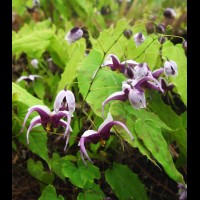
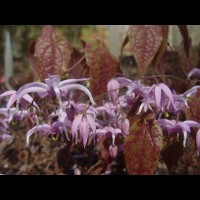
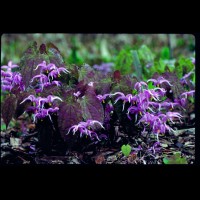
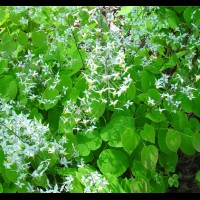
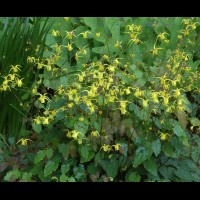
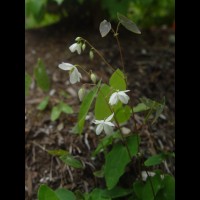
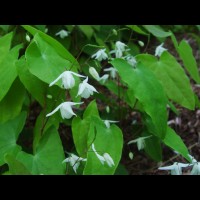
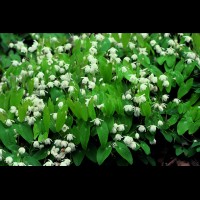
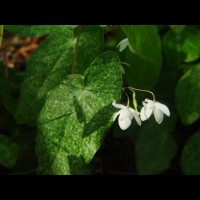
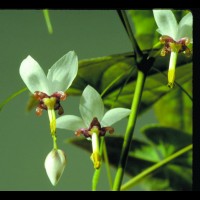
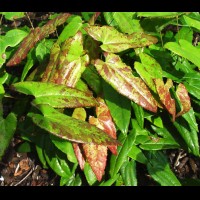
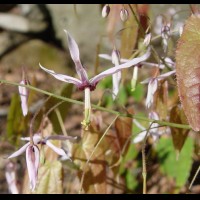
.jpg)
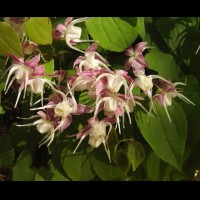
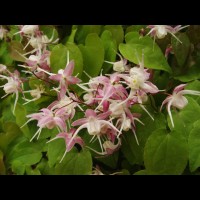
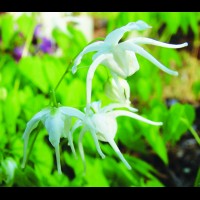
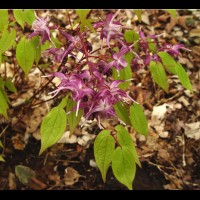
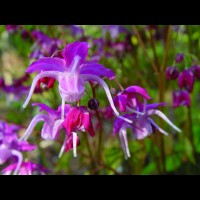

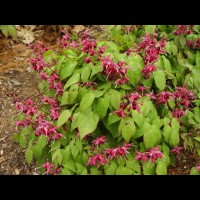
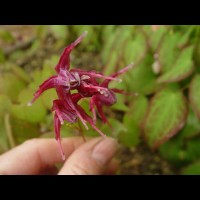
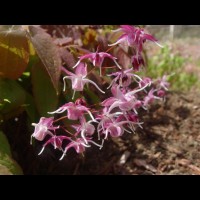
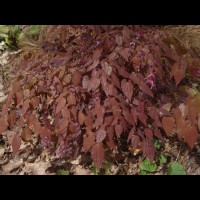
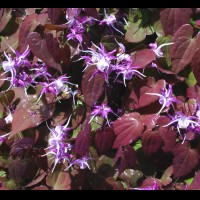
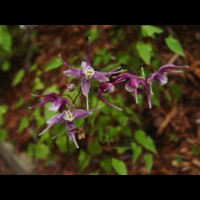
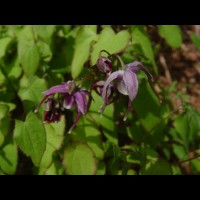

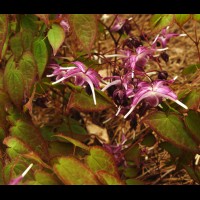
.jpg)

